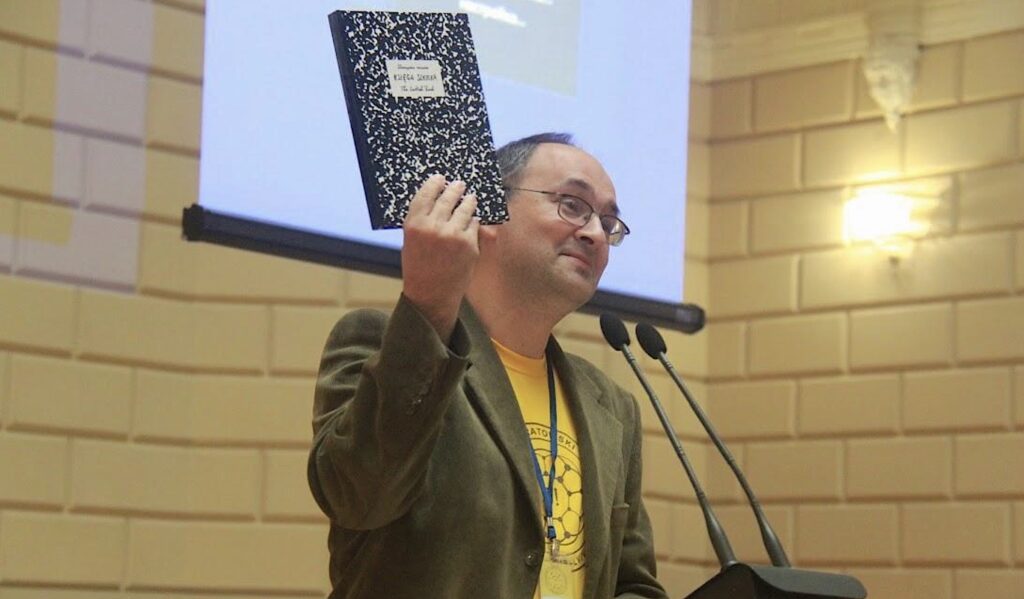
The Hungarian mathematician Alfréd Rényi famously said that a mathematician is a machine that turns coffee into theorems.1 Nowhere was this truer than in the legendary Scottish Café, which was located (contrary to what the name suggests) in the former Polish city of Lwów, now in Ukraine. The reason for going back to its former Polish identity is that it served as a cradle for the exciting developments, led by Polish mathematicians that have become embedded in many modern disciplines, notably real and functional analysis, set theory and logic.
The Scottish Café is conveniently situated in a square not far from the University of Lwów (now in Ukraine) in this historic city, along with a rival cafe, Café Roma, right across. It was the latter to which the mathematicians would gravitate after the meetings of the local chapter of the Polish Mathematical Society that comprised several ten minute talks. The mathematical discussions would spill over into the cafe over coffee or spirits. The two reigning deities, or founding fathers one might say, were Stefan Banach and Hugo Steinhaus. On a lighter note, the more “spirited” sessions were called Banachalia.2 After Banach was upset by the credit policy of Café Roma, the venue moved across to the Scottish Café and the rest, as they say, is history. The milieu fitted well into the “cafe culture” of European intelligentsia of those days, as epitomized by the famed “Vienna circle”3 of (largely) philosophers and the “lost generation”4 of writers, painters and artists of Paris.
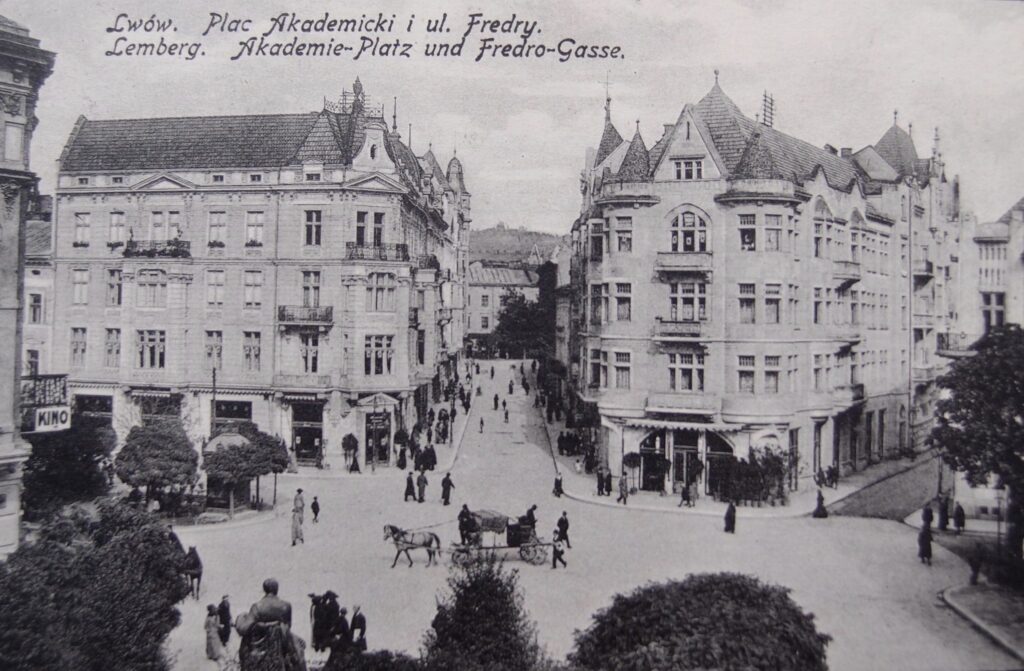
problems that remained unsolved continue to be worked upon, sometimes successfully, even to this day
Among the prizes offered were a dinner, wine, caviar, and so on, and once “a bottle of whisky of measure > 0” (by von Neumann), and the famous live goose by Mazur for a problem about existence of Schauder bases for separable Banach spaces (problem number 153, dated 6 November 1936). This problem was solved in 1972 by Per Enflo, a Swedish mathematician, who was invited to present it in a much publicized event in Warsaw, and was duly awarded his well earned goose.
The cafe itself has its own interesting history and was home not only to mathematicians, but also to philosophers and assorted artists and intellectuals of various hues, in addition to the many others, such as cattle traders coming to the Saturday market. See the accompanying article for an account by Chris Zielinski, the grandson of the then owner of the cafe, which graphically brings alive the atmosphere of the times.
During the world war, the group dissipated, with some members being killed, often executed by the Nazis or Russians, and some others emigrating to the USA. The ones killed by Nazis include Herman Auerbach who committed suicide in an extermination camp, Stanisław Saks, arrested and executed by the Gestapo as a member of Polish resistance, and Juliusz Schauder, killed while trying to escape. Some, such as Marcinkiewicz, Łomnicki and presumably Stefan Kaczmarz, who was lost without trace on the Russian side, were possibly killed in the well known mass execution by Russians of Polish officers fighting on their side [1]. A few were lucky enough to escape to the USA, Mark (Marek in Polish) Kac and Ulam among them, but at the cost of significant personal trauma [4], [10].
At the onset of the war, Mazur proposed that they bury the book in some safe spot and retrieve it after the war was over. What exactly happened thereafter is unclear, but after the war, it was in Banach’s custody. After his demise, Banach’s son handed it over to Steinhaus who painstakingly copied it by hand and sent it to Ulam. Ulam was by then in Los Alamos National Laboratory and forever nostalgic about the lost paradise of Lvov. Ulam translated it and circulated a mimeographed version of it in the Los Alamos National Laboratory. Beginning with that, largely as a culmination of the labour of love of R. Daniel Mauldin, it is now available in annotated form with much supplementary material [6].
a lot more of Banach’s work was lost compared to what was preserved
There are several amusing and informative anecdotes about the place from the reminiscences of former members. One about Banach’s working style by Ulam goes like this: very often a proposed problem would remain unresolved after hours of discussion. Then Banach would arrive the next day with several strands of arguments of varying degrees of correctness on scraps of paper, often put later in a satisfactory form by his former student Mazur. Many vouch that a lot more of Banach’s work was lost compared to what was preserved, because he produced results at an incredible rate and was not very careful about documenting them. Among the more amusing episodes is one during Henri Lebesgue’s visit, described by Mark Kac. Lebesgue was given a menu in Polish by the waiter, which he proceeded to stare at for a while before announcing, “Thank you, I only eat well-defined objects.”
As for the mathematics produced, the contribution of this Polish school is legendary. The manner in which it evolved is unique in history and deserves to be replicated elsewhere.5 In addition to the sheer quality, originality and intensity of the effort, the fact that it was a synergistic collaborative activity is not to be missed. And of course, never forget the coffee!
Acknowledgements I thank Prof. K.S. Mallikarjuna Rao for several valuable pointers to literature and blogs, and critical comments on the manuscript.
References
- [1] Joanna Diane Caytas, “Legacies from a holocaust of the mind”, Reviews of European Studies 11(1), 2019, 86–105
- [2] Roman Duda, Pearls from a Lost City: The Lvov School of Mathematics (translated by Daniel Davies), American Mathematical Society, 2014.
- [3] Emilia Jakimowicz and Adam Miranowicz (eds.), Stefan Banach: Remarkable Life, Brilliant Mathematics, Gdańsk University Press, 2011.
- [4] Mark Kac, Enigmas of Chance, University of California Press, 1987.
- [5] Roman Kaluza, Through a Reporter’s Eye: The Life of Stefan Banach (translated by Ann Kostant and Wojbor Woykzynski), Birkhäuser, 1996.
- [6] R. Daniel Mauldin, The Scottish Book (2nd edition), Birkhäuser, 2015.
- [7] Michiya Mori, “On the Scottish Book Problem 155 by Mazur and Sternbach”, arXiv preprint arXiv:2308.03339, 2023.
- [8] Dmitry Ryabogin, “A negative answer to Ulam’s Problem 19 from the Scottish Book,” Annals of Mathematics (2) 195 (3), 2022, 1111 – 1150.
- [9] Adriana Salerno, “Coffee into theorems”, https://blogs.ams.org/phdplus/2015/04/28/coffee-into-theorems/.
- [10] Stanisław Ulam, Adventures of a Mathematician, University of California Press, 1991.
Mathematicians at the Scottish Café*
By Chris Zielinski
Between 1935 and 1941, The Scottish Book – a collection of almost 200 mathematical problems – was compiled by a group of Polish mathematicians who gathered at the Scottish Café in the Polish (earlier Austro-Hungarian/now Ukrainian) city of Lwów (Lemberg/Lviv).6 The Scottish Café had nothing to do with Scotland. It was owned by the author’s grandfather, Tomasz Zielinski. The Scottish Book and its problems survived World War II (a successor tome is being compiled and kept at the University of Wroclaw, Poland). Many members of this Lwów School of Mathematics went on to have illustrious careers and make indelible contributions to their chosen subject. This paper describes the evidence on the Scottish Book and the history of the various participants in this small but lasting component of the edifice of modern mathematics, which has been termed a “classic in mathematical thought”.
Prologue
It was like an American Western of the 1890s – except that it was August 1937 in the far East of Poland: the door of the Café opened and a tall, dark stranger walked in. He was over six feet tall and broad shouldered. He had the slightly sad air of a gipsy. There was a pause as everyone in the Scottish Café took a covert glance, then resumed their conversations. Except for those at the long table in the back, who looked up and got to their feet. A smaller, antic young man who had entered with the colossus now stepped forward and introduced him to the group, “This is John von Neumann,” he said.
Von Neumann had been in Lwów once before, ten years ago, and he wasn’t a stranger to many of the older mathematicians, philosophers and dreamers who filled the Café. A long-time friend of Stanisław Ulam’s – the shorter man who had introduced him – they had been taking turns. Ulam would come to teach at Harvard at von Neumann’s invitation, and then spend the summers at home in Lwów. Von Neumann would come to Lwów for the occasional major conferences held in Lwów. In between his visits, von Neumann’s reputation had grown. Now he was fully in the ascendant, capable of provoking awe with his incisive, original thought – but he was also good at telling jokes. The conversation grew louder.
A second undisputed genius was also sitting at the table – Stefan Banach, as tall and broad as von Neumann, and with an equally original character. But Banach was blond, and he dressed much less formally than von Neumann. They worked in similar domains – von Neumann was later to generalize and expand many of Banach’s ideas – and held high opinions of each other’s worth. Banach was the anchor for the whole Lwów School of Mathematics which gathered at his table.
We will later meet more of the cast at the Scottish Café in Lwów between the Wars. Almost all the others at the table also contributed important ideas – and often their names – to the study of mathematics, and to the practical applications that resulted from their equations. As technology developed, much of this work fed into the new fields that were emerging, notably computer science (Von Neumann and Ulam were involved in designing and operating the first machines constructed), probability theory, topography, number and set theory, game theory, and various allied mathematical fields.
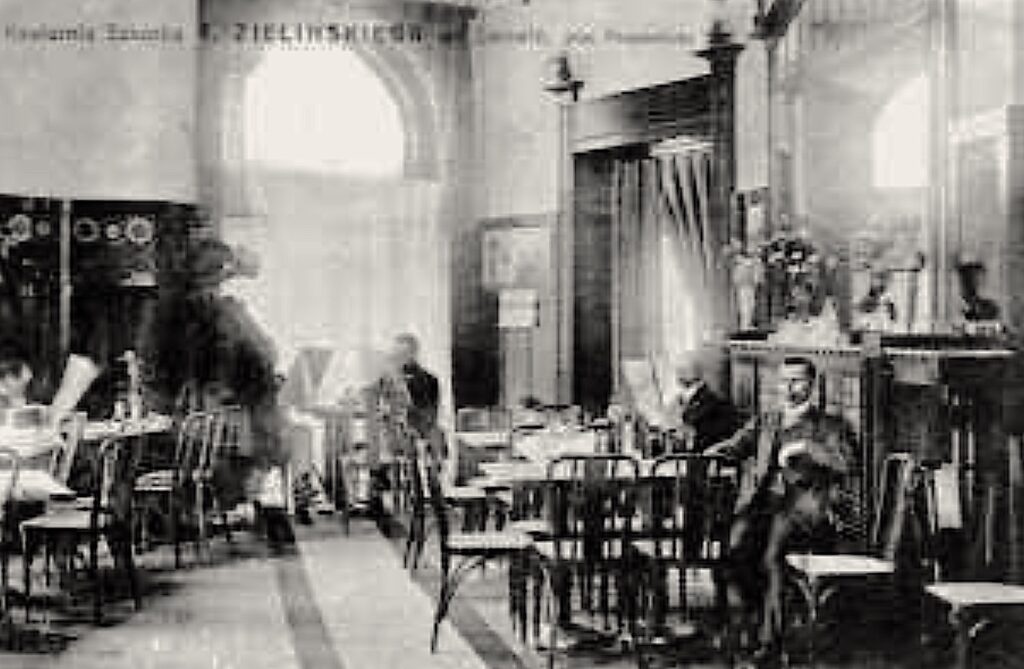 |
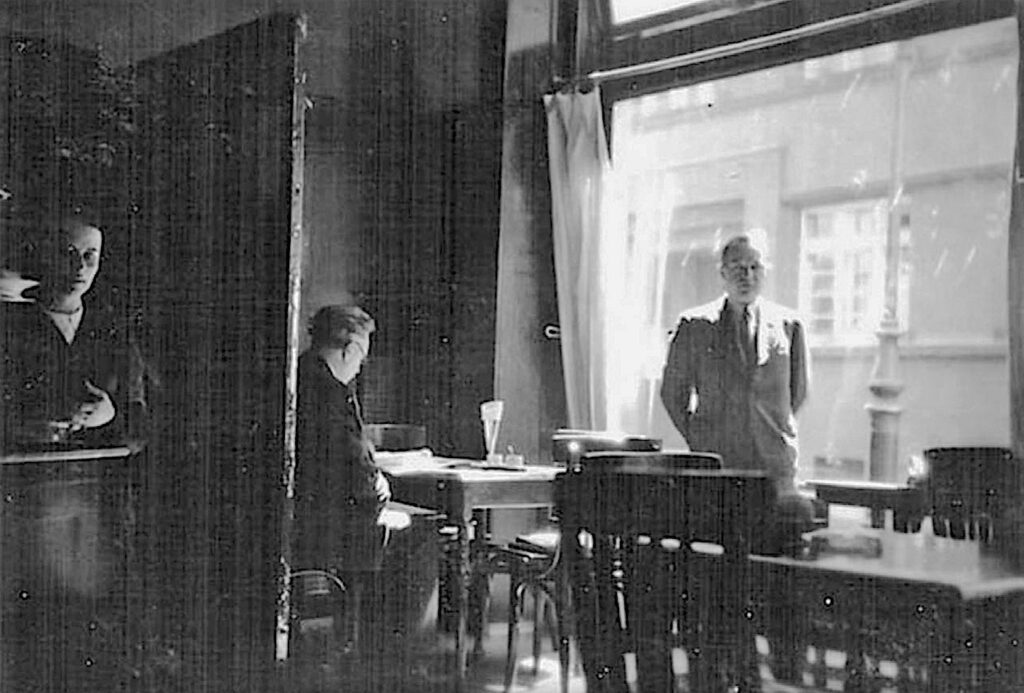 |
| Inside the Scottish Café during the 1920s. The image on the left is courtesy of: Polish School of Mathematics, and the image on the right is courtesy of: Wroclaw University of Technology | |
During and after the War, about a third of the table emigrated to the US, where they became professors in new American faculties and were responsible for mathematical and technological innovations that propelled America’s post-War rise as a global industrial power. Several (including Ulam and von Neumann) worked on the Manhattan Project, constructing the first atom bombs.
Another third stayed home – well, to be exact, they stayed in Poland by leaving their homes in Lwów and moving to Warsaw or Wroclaw. The whole east of Poland was taken by the Soviets, to be divided up into SSRs – Lwów and its surrounds became part of a new Ukrainian SSR, and later Ukraine.
And finally, at least a third of the mathematicians died during the War – mostly lined up against a wall and shot, some mowed down in cellars and fields, some in the extermination camps…. But even they left some mathematical gems behind.
“The Book,” shouted von Neumann. “Give me the Book. I have some new problems.” And a waiter was sent out to the secret place where the Scottish Book of Mathematics was kept. A simple exercise book in marbled black covers, this was laid reverently on a small table in front of von Neumann. The mathematicians grew quiet as he unscrewed the cap of his pen and began to write.
Introduction
This is an account of the brief flowering of a school of mathematics in Eastern Europe in the years between World War I and World War II. Leading members of the school met almost every day in Lwów at the Scottish Café, where they discussed and considered and set problems in evolving mathematical topics of the day. A journal was founded and published, international connections made, congresses held. A book of problems – The Scottish Book – was initiated and kept at the Café for mathematicians to work on, solve, refute, or add to. Famous mathematicians visited, including such household names as Birkhoff, Fresnel, Lebesgue and John von Neumann.
The Scottish Book somehow survived the carnage of World War II and persists to this day (in Wroclaw) as the cornerstone of a “Scottish School of Mathematics”, which has little to do with Scotland, but everything with a Café in a formerly Polish city now in the Ukraine.
This would be a matter of only local interest if the mathematics was not superior. In fact, it was world-class. A number of new branches of mathematics were established and their domains vastly extended over those little marble tables. Dozens of papers are still being written citing the works of those mathematicians. Many of them emigrated just before or after the War and went on to activities in technology – and were involved in work that was fundamental to the emergence of the Computer Age. Many died in the War, but live on with their names attached to an axiom, a lemma, a space or a fractal. Thus, this short history seeks to give an entirely factual, but at the same time impressionistic, account of the mathematicians and their world at the Scottish Café, trying to put them in a social context.
The paper is based on a comprehensive reading of the growing literature on the era, on personal visits to the location, and on some family history.
Tracing the impact of all the mathematics devised during the flourishing of the Lwów School of Mathematics would be a major task beyond the scope of this paper, owing to its scale. Almost all of modern mathematics owes something to this group of mathematicians – as do fields like quantum physics, econometrics, computer science, and algorithmic number theory. Nevertheless, I will sketch out the main streams of posthumous development.
Brochwicz-Lewinski and the Scottish Café Building
Since the events we will relate happen in a specific and special building, it may be of interest to understand how that building came to be.
Zbigniew Brochwicz-Lewinski was 26 when he successfully completed his architectural studies at the St. Petersburg School of Fine Art in 1903.7 A year later, when the Russo-Japanese war broke out, Lewinski escaped being drafted into the Imperial Russian Army by moving south to the Austro-Hungarian city of Lemberg.
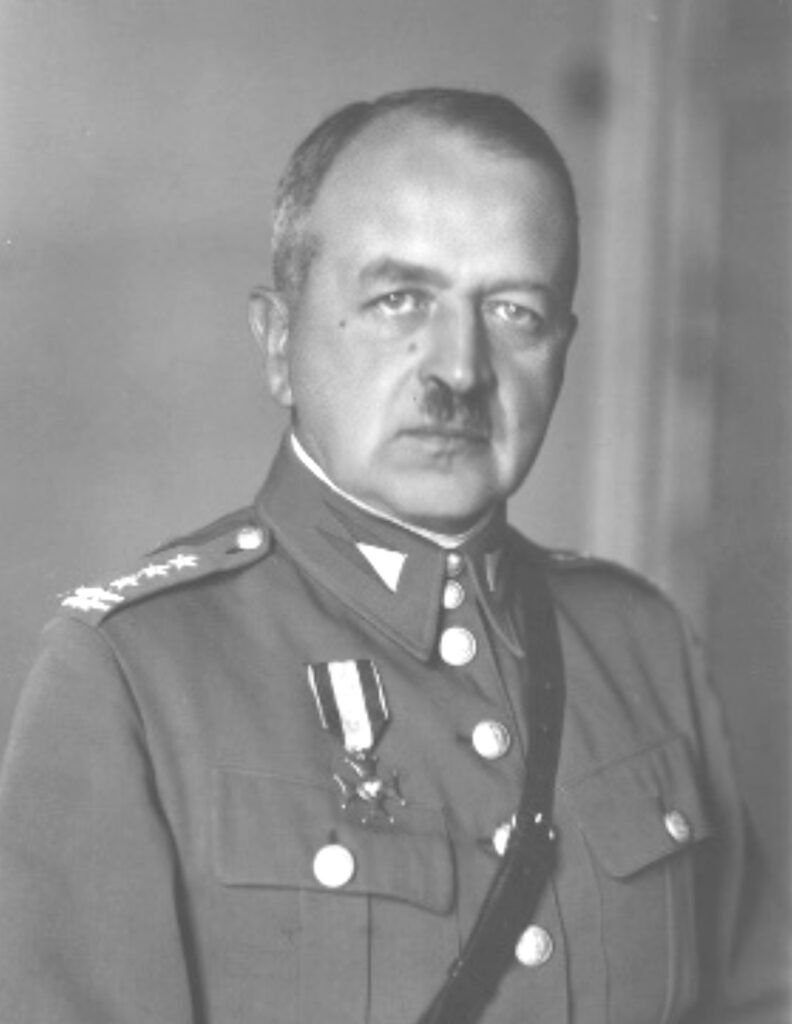
Brochwicz-Lewinski’s buildings offer a clear testimony to the influences of his architectural upbringing in imperial St. Petersburg, mingled with his own streak of pure fantasy. These are distinguishing features of the four-storey townhouse that housed the Scottish Café, which Brochwicz-Lewinski built for the entrepreneur Emil Weksler in 1908-9.
Throughout his life, Brochwicz-Lewinski exhibited a rare blend of the practical artist and the military man. His architectural work in Lwów effectively ended with the onset of World War I, when his military career took over in earnest. For the next thirty years, Lewinski fought in every war possible – World War I, the Polish-Ukrainian War, the Polish-Bolshevik war, and finally World War II – amassing medals and rising to evermore-senior ranks as he went. And then, as Hitler invaded France, the pendulum swung again. In 1940, Brochwicz-Lewinski was posted to Scotland to look after army families stationed there. He liked it so much he stayed on after the war. At the age of 62, he embarked on his third career – as an artist. Not as a Sunday dauber, either: in the ten years before he died (in Glasgow, in 1951) he had achieved a reputation as one of Poland’s leading 20th Century artists. A remarkable man.
Yes, Scotland. An appropriate destination for the architect who was responsible for Lwów’s Scottish Café. To the city’s citizens, the residential townhouse, with its two towers and swirling modernized Gothic balconies looked so much like a Scottish castle from a romantic novel, that the Café located on its ground floor could have no other name.9 Situated at one corner of Academic Square, 100 metres from the old University, the Café was destined to become the magnet for a mathematical revolution.
Tomasz Zielinski and the Scottish Café
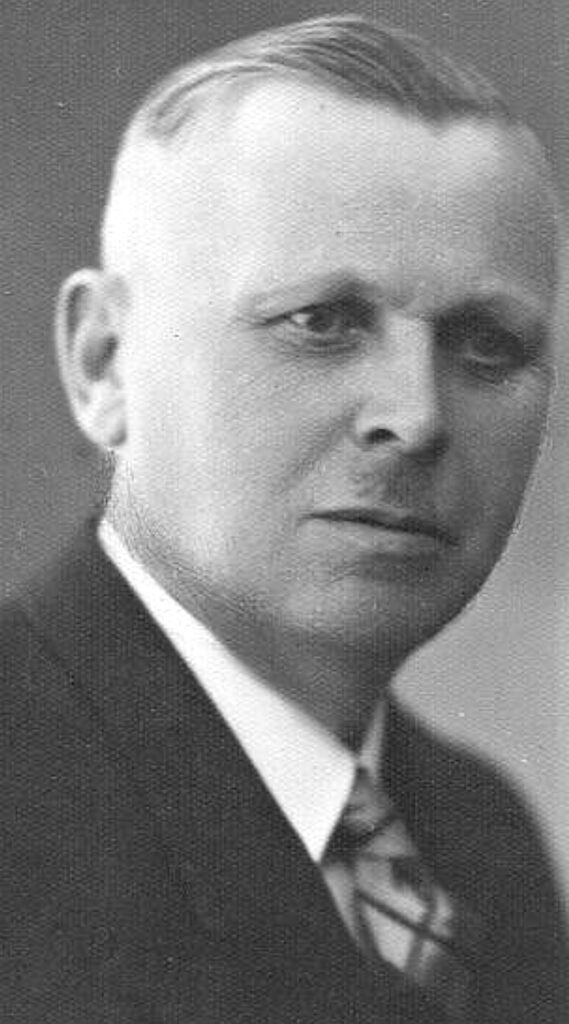
In the literature surrounding the story of the Scottish Café, Tomasz appears at various points as a concerned proprietor, anxious that his marble-topped tables were being defaced by the scribbling mathematicians who began to drift in after the various wars receded, and as the University and Polytechnic revived. But he was also sensitive to the possible significance of their academic work, causing scribbled-on tables to be stored until the perpetrators could copy the text onto paper the following day. What was almost as important was his tolerance when it came to the complex arithmetic involved in paying the bill: here he showed his heart.
At first, the mathematicians would meet Banach at the Café Roma directly across the street from the Scottish Café. But the owners there clearly ran a tighter ship than my grandfather did. They demanded payment on consumption. Offended by the lack of credit extended to him and other impecunious academics, Banach picked up his papers and crossed the road. Around 1930, thus, the Scottish Café took over as the centre of Lwów’s – and for a while the world’s – mathematical universe.
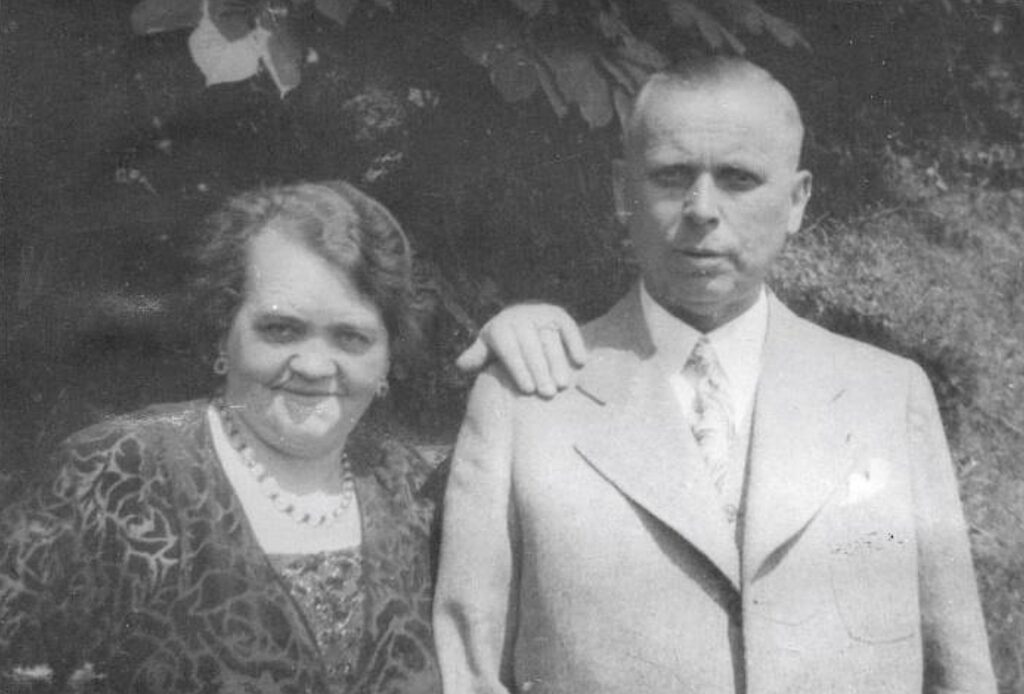
How the Scottish Café fell into my grandfather’s hands is a mystery to me. I never met the man, but archival records show he came from a farming family, as did my grandmother. Still, in short order, he somehow acquired the capital to buy the Scottish Café, as well as a nearby 4-storey apartment building which served as the family’s city residence, and a sizeable country estate including the hydrotherapy spa Marjówka on the edge of town. He owned all of these throughout the inter-war years. Wherever he got the money from, it certainly wasn’t from selling cups of coffee to mathematicians.
Knajpes and the Scottish Café
When World War I ended in November 1918, Poland emerged from partition and Lwów found itself integrated into a culturally and intellectually starved nation. Peace did not come immediately, though, as Lwów played a central role in both the Polish-Ukrainian War and the Polish-Soviet War. By March 1921, hostilities finally stopped and a genuine peace arrived. This was to last 18 years until the German invasion of Poland on 1 September 1939.
Those inter-war years saw Lwów thrive. During this all-too-brief interlude, it was a multicultural city, boasting several universities and a vibrant artistic and intellectual society. Knaijpes flourished – the local term for Jazz Age “joints”.10 Clubs and bars and cafés offered high life and low life depending on your tastes and wallet. There was a palpable energy and sense of iconoclasm evident. Everything must change! The Roaring 20s were fully in operation in Lwów, with a Polish tinge, but roaring there just as much as they did everywhere else. Jazz, cabaret, painting, cinema, the dance craze, fashion – local versions of all were developed, and all levels of society were affected.
So let us walk to the corner of Academic Square and push open the doors of the Scottish Café. At that time, it occupied the whole ground floor of the building. Photos show a long wide room with an oriental carpet on the marble floor, on which some 20 tables of various sizes and shapes are scattered – a row of squarish tables by the windows, and round and larger rectangular tables elsewhere. Central towards the back, next to the billiards table, is the largest table – the “Stammtisch” for larger gatherings. This is where Banach and his mathematicians would have sat. An ornate gilt-framed mirror covers the back wall, reflecting the row of brass chandeliers hanging from the high ceiling. The walls are cream; racked along a cream waiters’ side-table are cake stands topped with bunches of flowers. Each table is hemmed in by wooden art-deco chairs with S-shaped backs and solid seats. These must have been springy and comfortable, given the lengthy duration of some of the mathematical deliberations they supported – over 17 hours in not a few cases, according to Ulam ([13], p. 33). From the photos it seems there was adequate space for at least 50 customers at a time – but not much more.
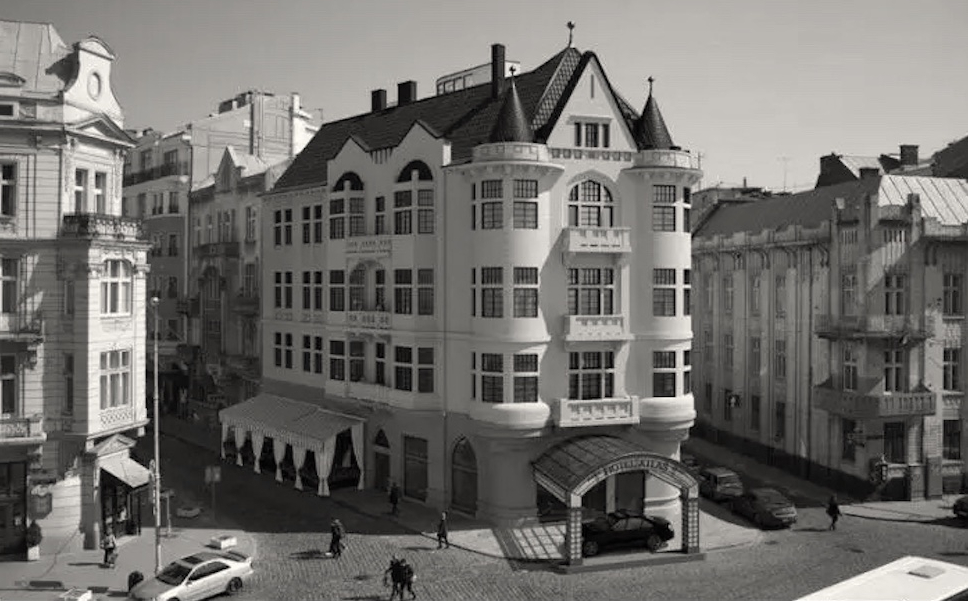
Who were these 50? Histories of mathematics understandably focus entirely on the mathematicians. However, despite the descriptions of the Café in the memoirs I have consulted, they certainly weren’t all mathematicians. What is striking, if you cast your net wider, is the amazing density and diversity of culture that filled the space. There were completely parallel universes operating in the same room, and evidently at the same time.
For example, while the mathematicians were contemplating Banach spaces at one table, speaking in sudden bursts and sketching geometric shapes on the table tops, Roman Jaworski and his friends were conducting regular sessions of the Constructivists’ Club (Klub Konstrukcjonalistów) at another, and there the norm, indeed the requirement, was to orate as mellifluously as possible.11 The Constructivists talked up a synthesis of culture, science and technical knowledge that was to appear in art, poetry and theatre. According to Radoslaw Okulicz-Kozaryn “The topics of the conversations of its members were very broad, and their philosophy, developed primarily by Roman Jaworski, included mainly aesthetic issues. Constructivism was supposed to be a way to save art in the period of multiple changes taking place in the modern world” ([14], p. 158). The Constructivists Club rules demanded elegance and refinement in clothing and behaviour – quite different from the motley attire and robust behaviour of the mathematicians. There is a whole parallel story about Constructivism and the Scottish Café to write, which I will omit here.

To counterbalance the intellectual heavyweights, tables were regularly occupied by the arty, noisy, chatty radio people who came to the Café to discuss and write the scripts for the Wesola Lwowska Fala (A Cheery Wave from Lwów) cabaret, a very popular programme which was beamed out twice a week throughout Poland. Journalists scribbled at the tables – including Bruno Winawer, who wrote his popular socio-scientific comedies and columns on science and literature here.
Apart from spouting mathematical and other fantasies, people played billiards or chess. The cattle traders who used to come from all over Galicia to the big Saturday market held in the square outside would sit and reflect about changing times. Although the square no longer filled up with animals, as the market had moved elsewhere, the traders still habitually came to the Scottish Café.
And there were of course lone stars sitting in the tables between these distinct groups, some of them quite special. For example, there were sightings of the pianist Artur Rubinstein, home in Lwów between world tours. The future Prime Ministers of Poland and Mongolia occasionally appeared for a coffee and a chat. Writers such as Bruno Schulz – as unique as Kafka, and a remarkable painter as well – would drop in on one of his frequent visits from nearby Drohobycz (where he was born, where he taught art at school, and where a Nazi killed him) [15]. Another was the young Stanisław Lem, the future science fiction writer, who would come in for a warm milk and honey, just out of boyish curiosity about the famous names inside.13
Apart from spouting mathematical and other fantasies, people played billiards or chess
And another fascinating coincidence of careers brought into the same room Simon Wiesenthal, the future Nazi hunter, Raphael Lemkin, the originator of the term “genocide”, and perhaps Hersh Lauterpacht, who established the concept of “crimes against humanity” in the legal framework. As it happens, all three were in Lwów in the summer of 1928. Wiesenthal was studying architecture at the nearby University. Lemkin had two longer spells in Lwów – in the early 20s, when he would show up to ponder his linguistics studies and draft translations, sitting by a window, and from 1926 to 1929 when he did his law degree. He would stroll over to the Café from the University, and think the thoughts that led him to originate the word and concept of “genocide”. His subsequent career was largely focused on developing the legal weapons to detect and fight genocide through legislation and the United Nations. Strange to think about Wiesenthal and Lemkin both sitting in the Café, blissfully unaware of the terrible history that would bring them a sad renown and consume so much of their future lives.
The circumstances are different regarding the originator of genocide and the father of “crimes against humanity” – the two rival accusations flung at Frank, Goering, Hess, and other Nazi leaders during the Nuremberg War Crime Trials. Both of these lawyers were from Lwów. According to Philippe Sands, “Lemkin and Lauterpacht had had the same teachers at law school… both of them attended the first post-War Conference of the International Law Association in Cambridge in August 1946, [and this was] the first time I could place Lauterpacht and Lemkin in the same town and building at the same time” ([16], p.464). We have no eyewitness evidence for it, but they could have rubbed shoulders in the Scottish Café in 1928….
The more one delves into the clientele, the more remarkable it seems that so many varied and irrepressible memes were spread unstoppably throughout the world from a little-known corner of Galicia, launched by the extraordinary individuals sipping a coffee or chewing a chop at my grandfather’s Café.
Let’s take a closer look at the mathematicians.
Mathematicians In The Scottish Café
The Academic Scene
It is unfortunately relatively easy to situate the Lwów School of Mathematics, which developed in the ambience of the Scottish Café, in the overall history of Polish mathematics – because there is almost no history to recite. Since 1795, Poland had been partitioned between Austria, Germany and Russia. In consequence, it largely missed the rapid development of the sciences in the 19th century. As Zelazko notes, “in the 19th century the essential effort of the nation was devoted to the humanities, since literature and poetry were necessary for supporting the idea of independence and even for the preservation of the language” [17]. Such mathematical work as was produced was written in Polish, he says, and therefore lost to the wider world.
When the partition ended with the end of World War I, a reborn Poland sprang to vivid academic life. The key drivers of this mathematical renaissance were in Warsaw and Lwów. At Warsaw University, under the impetus of Zygmunt Janiszewski, the new journal Fundamenta Mathematicae became the world’s first specialized journal in the field of mathematics. Unfortunately, Janiszewski died precisely as issue one was being set in type.
In Lwów, the two institutions relevant to mathematics were the University and the Polytechnic. What was then called the Jan Kazimierz University was founded in 1661. In 1934/5 the University had 5,900 students in five faculties, of which 870 studied in the Mathematical-Biological Faculty. Of the larger religious groups, 64% were Roman Catholic, 21% were Jewish, and 13% were Greek-Catholic. The Polytechnic was originally established in 1816. During the interwar years, it was called Lwów Polytechnic School and then, from 1921 on, Lwów Polytechnic.14
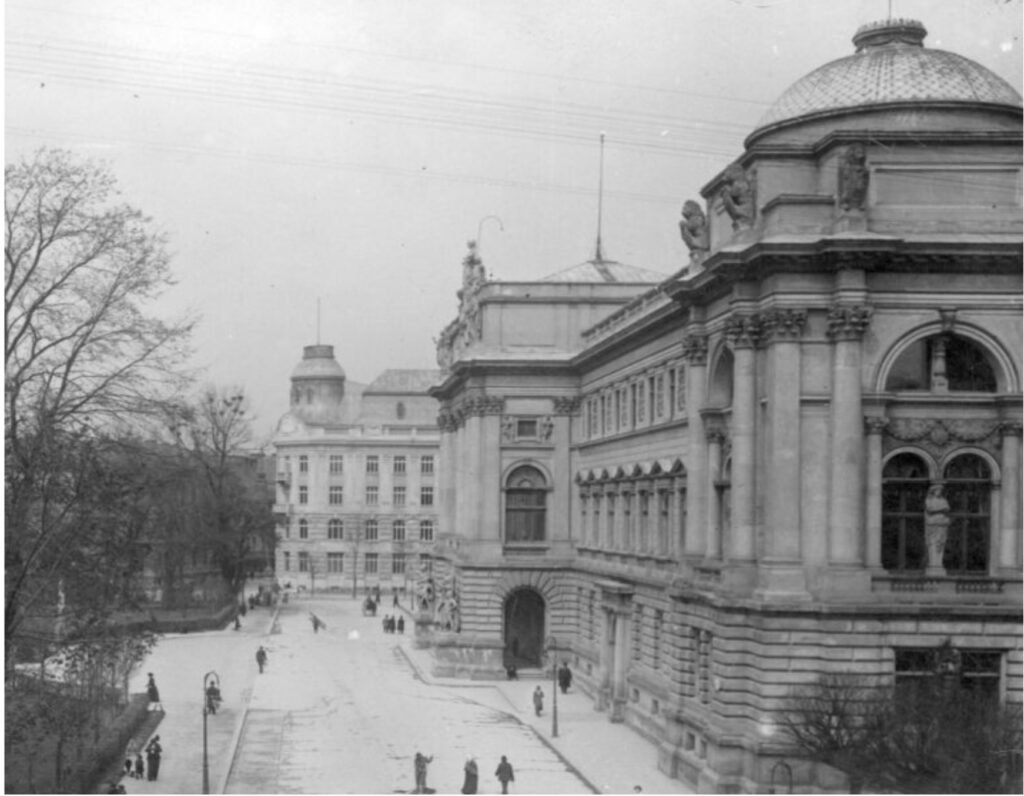
The overwhelming impression from the literature is that the Lwów students had a palpable enthusiasm for their studies. Discussions about mathematics would spill out of the lecture rooms and into the streets and cafes. Mathematical tea parties were held. Students would often visit each other’s homes to pursue topics of mathematical interest. Memoirs frequently refer to the febrile, passionate atmosphere surrounding this most abstruse of subjects – and not just in Lwów, but in Warsaw and Krakow as well.
One particularly passionate mathematical discussion had a major impact on the creation of the Lwów School, and it took place in Kraków’s Planty Park in 1916. Stefan Banach and Otto Nikodym, both in their 20s, were seated on a park bench discussing the Lebesgue integral, as one does on a sunny afternoon. They were passionate about it. Voices were raised. A nattily dressed military man walked by – Hugo Steinhaus, a lancer in the Polish legion, with a doctorate in mathematics from Göttingen. He watched the two debate, stepped forward and introduced himself ([18], pp. 7–15). Both Nikodym and Banach subsequently came to Lwów to study at the Lwów Polytechnic under Steinhaus. Nikodym went on to have an illustrious career as a Professor of Mathematics in Warsaw and then in the United States of America. Stefan Banach became Stefan Banach.
Stefan Banach

Banach was a mathematical genius, although it was a while before this was recognized. His birth and early life had not been promising. His father, Stefan Greczek, was a railway official and his mother was unknown (his surname comes from a laundress, Katarzyna Banach, who played no further role in his life). Years later, Greczek told his famous son that he had been too poor to marry his mother. Young Stefan’s life was one of careful poverty. While he was still in school, he started to give lessons. He never stopped.
Whether the Lebesgue integral discussion in Planty Park was in fact a tutorial by Banach, we will never know, but an important result was that when he came to study at the Lwów Polytechnic, he had a friend in Steinhaus, who had become a Professor there. In due course, with Steinhaus’ help, Banach became an Assistant and then a Professor, and eventually a Faculty Dean at the University. This was despite a lack of formal qualifications – after struggling to get a mediocre pass in his high school leaving examinations, he only completed two semesters of undergraduate studies.
But it didn’t matter, because Banach was obviously special. Soon after he arrived in Lwów, Prof Steinhaus gave him a difficult problem to solve, which he did in a day, with ease. The solution was the basis of their first joint publication, and they continued to collaborate from then on, co-authoring papers, starting a mathematical journal (Studia Mathematicase) and writing problems into the Scottish Book. Banach married Lucy and moved along professionally. Life was good.
He was a true original. Tall, blond and blue-eyed, informal and perennially insolvent – academic salaries were a joke – it was this latter characteristic that persuaded him to abandon his earlier perch in the Café Roma and cross the road to the Scottish Café.
Banach was the centre of the Lwów School of Mathematics at the Scottish Café. He could work anywhere. Noise didn’t bother him. In musical venues, his preferred working seat was next to the orchestra. His mind purred on with a famous lucidity. He loved coffee and cognac and was happy sitting in the Scottish Café, talking mathematics with almost anyone – but you had to be up for it, as he didn’t suffer fools. Unlike the dapper Prof Steinhaus, Banach was informal, to the extent that he was somewhat scorned for his short-sleeved shirts, lack of a tie, and his familiar way with students – all deemed to be not professorial at all.
But it was the impact of his personality, his single-minded pursuit of ideas and solutions, that animated the Lwów School of Mathematics. Meetings were irregular at first, but then they settled into a regular, daily pattern. The Scottish Café filled with mathematicians. Banach’s prize students always sat with him at the head table – Herman Auerbach, Stanisław Mazur, and Stanisław Ulam were always there – but many others joined in, a number of them going on to achieve international fame. There are almost 30 mathematicians associated with the Lwów School of Mathematics (see the annex Appendix and photos), and it is beyond the scope of this paper to provide more than summary detail regarding specific individual lives and work.
Banach was the centre of the Lwów School of Mathematics at the Scottish Café
What did they talk about? According to Ulam (cf. [19], pp. 49–58):
The main propulsion of the original research work were the areas of set theory: the basis of set theory, set topology, and then – under the influence of Banach and Steinhaus – functional analysis with applications for classical analysis. Schauder, who was a university lecturer, dealt with partial differential equations. His methods and results have become classic today[…]. Banach, Mazur and Schauder are the creators of the popular method of treating analysis problems using geometric methods of function spaces.
As the mathematical conversations went wider and deeper in functional analysis, set theory, topology, and probability, it became a standard procedure to formulate ideas as problems, and then to share them in what became the American “brainstorm” – developed years later as a formal technique at Los Alamos by Ulam, von Neumann and others (cf. [20]).
Sometimes their effort began with searching for a problem. Then someone on the tabletop drew a simple figure or wrote characters like y = f (x -t- z)[…]. Thanks to this heuristic, original questions were often formulated or mathematical paradoxes were invented. In most cases, Banach, Ulam or Mazur came to the Café with a well-defined problem[…]. The adventure began. The participants of the session tried to look at the issue. Their thoughts wandered freely through Banach’s spaces. There were long moments of reflection, concentration and tension. They thought intuitively or analytically. […]Banach processed information instantly, like a computer, so not everyone could keep up with it. He did not like to walk around the beaten tracks, but he looked for new ways, looked for distant and surprising associations, often looked into each other’s eyes, drank coffee or cognac, burned out a lot of cigarettes: they drank too much, they smoked too much, and time seemed to have stopped.
What a wonderful picture of a group think – this ruminating body of men (there were no female mathematicians in the faculty at that time), concentrated, grunting the occasional comment, absorbed in the problem. And then [20]:
Often it happened that one of the scholars – sometimes Banach, sometimes Ulam. sometimes Mazur – experienced a revelation[…]. Like a flash of light, there was the initial idea of a solution. If it was an interesting trail, they would write it on a table top or on napkins. Together, they experienced a feeling of joy and relief, satisfaction and pride. Then they tried to prove the claim using the deductive method. Table tops were densely covered with mathematical signs. When Banach saw that they were beginning to err, he never expressed strong opposition. Rather, he posed new questions, made gentle remarks that often allowed him to find the right path.
Apart from illustrating the method, this quotation points to the very real need for The Scottish Book.
The Scottish Book
The mathematicians came to the Scottish Café armed with soft lead pencils. With these, they attacked the marble tops of the tables, which were easy to write on and, just as important, readily erasable. One commentator explains: “The Scottish Café was organized in a Viennese style. Small tables with marble surfaces were very useful to serve as slates which they covered with numbers. This at first did not arouse the excessive joy of the owner, but after a while Zielinski got used to such `ruination’ of his property. After all, the tables were not being occupied by teenage idiots but by serious university and polytechnic professors.” (cf. [20])
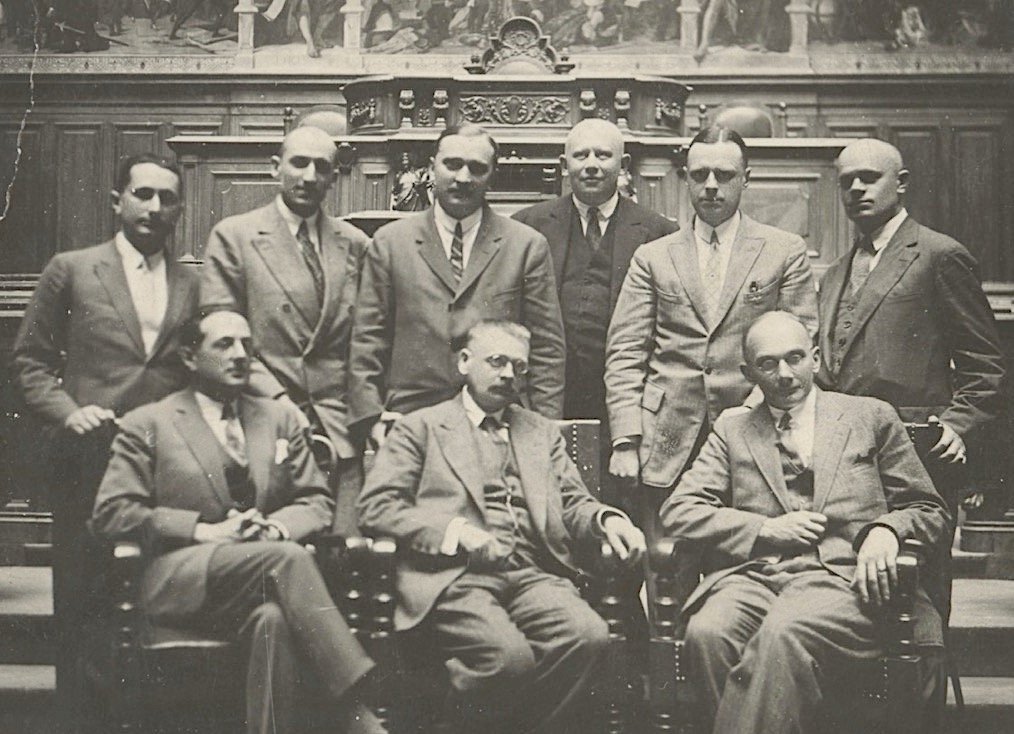
In the evenings, as the customers were shooed away, the tables were often wiped down and the chairs placed upside down on them so the floor could be swept as well. One can only imagine the agonized faces of the mathematicians coming back the next day to continue their theoretical work only to find it had been washed away by an industrious cleaner. Some were saved by the intercession of the owner. A partial solution was introduced. According to Urbanek (cf. [21], p. 111), after one of Banach’s major evening bursts of mathematical genius had vanished by the next morning, “One day Professor Łomnicki came in… and said that if this happens again, to, please, always leave the writing on the table as it is and store the table somewhere until the next day.” So the scribbled-on tables were covered with a cloth and set aside. The cleaners who came in the morning were told that such tables should not be washed, and around 11 o’clock a student would come in and transcribe the mess onto paper. This process worked, at a pinch, but it made nobody happy.

Someone (I suppose Banach, because it was his notebook and he set the first problem) scrawled “Księga Szkocka” (The Scottish Book) on the front page. Thereafter pages were filled in with a problem on the left-hand page and its eventual solution (if there ever was one – quite a number of problems remain unsolved today) on the right. The names of the problem setter and solver were entered, as was the date. Small prizes were offered for solutions: a bottle of wine, five beers, a live goose – the goose was handed over by Mazur in 1972 when Per Enfilo of Sweden provided a negative solution for problem 153. Although the prizes suggest a certain levity, adding problems to the book was not an impromptu act. As Ulam wrote, “Most of the questions proposed were supposed to have had considerable attention devoted to them before an ‘official’ inclusion into the ‘Book’ was considered” (cf. [22], p. 32). This accounts for its persisting relevance and durability.16user, Boston. ISBN 3-7643-3045-7 (1981).}
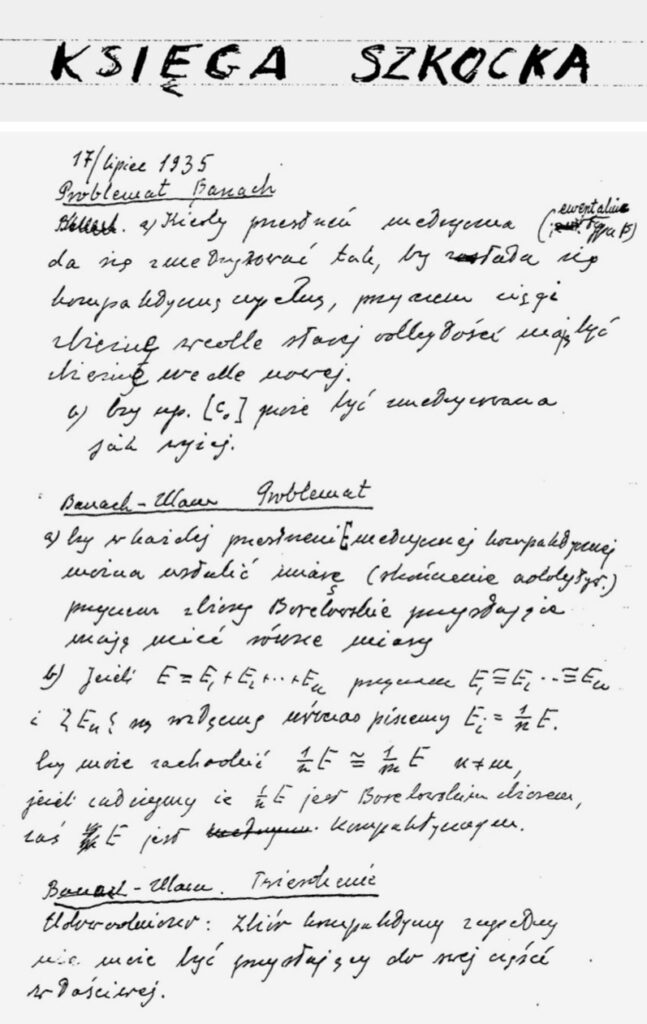
Opinions vary about who looked after the Book in the Café, and where it was hidden when not in use. Suggestions about the guardian include the head waiter “who, upon demand, would bring it out of some secure hiding place, leave it at the table, and after the guests departed, return it to its secret location” [22]. Ulam’s version is that “This notebook was stored in the Café and the waiter brought it on demand. We wrote-in the problem and the waiter ceremoniously took it back to the place where it was hidden” [25]. Hugo Steinhaus claims that the Scottish Book was not kept by the cloakroom attendant, nor by a waiter or the owner, but by another paid member of staff [26], but Bogdan Mis insists the book was “stored in a cloakroom and provided to mathematicians on request: anyone could post a solution to a problem” [27]. And when the Café was closed, the Book was given to the owner, Tomasz Zielinski, who “treated it very carefully. Evidently, he understood its historical value” [28].
As the years went by, the mathematicians in the Scottish Café continued to perform their mental acrobatics and enter the fruits of their thoughts and discussions into the book. The left-hand pages filled with questions and many right-hand pages offered answers. A substantive analysis of the book and its numerous authors has been done thoroughly in the referenced literature.
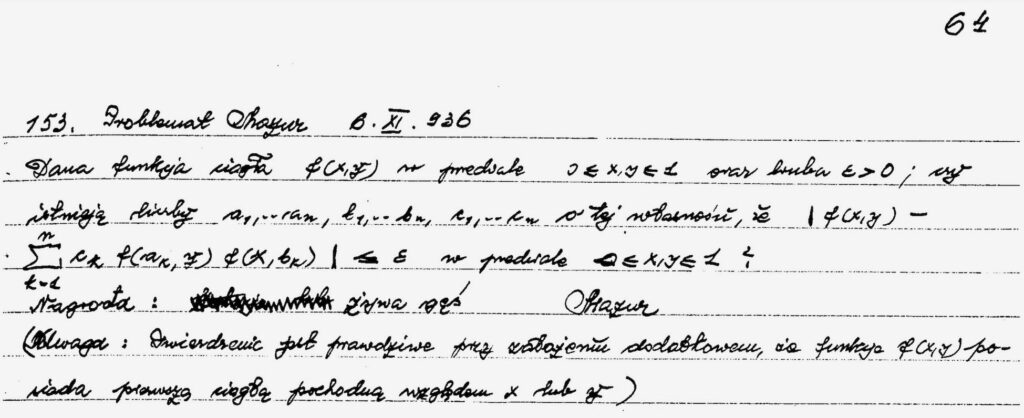 |
 |
So the book proved to be not only good for Mr. Zielinski’s marble tables, but for the field of mathematics. Results from this work have infiltrated much of modern mathematics, and the book still has an absolute value as a repository and source of unsolved problems.
The Beginning and the End of Everything
The End of the Scottish Book and Scottish Café
In 1939, a couple of weeks before World War II started, Mazur told Ulam that “if the city is bombed, I will put all the manuscripts and the Scottish Book into a case and bury it somewhere”. The suggested location was to be “near the goal post of a football field outside the city” [22]. It is uncertain that this ever happened. In effect, World War II broke out on 1 September 1939, and by 17 September, the German Blitzkrieg had swept over the whole of Poland from West to East and right up to a hill at the borders of Lwów. The Germans sat on this hill with their artillery, taking pot-shots at city landmarks, but mercifully for only a few days. The German-Soviet Non-aggression Pact (or Molotov-Ribbentrop Pact), which had been signed the previous month, took effect, and the Soviets rolled into Lwów, relieving the Germans of their task, on 22 September 1939. They stayed there until July 1941.
Problems kept being added to the Scottish Book during the Soviet occupation. Ulam notes that “some Russian mathematicians must have visited the town; they left several problems (and prizes for their solutions)” [22]. So the Café continued to operate under the Soviets. The last entry, no 193, was dated 31 May 1941 – a problem set by Hugo Steinhaus about the distribution of matches in a box.
This was the point at which the Soviet/German Pact broke down. Hitler marched his forces into Soviet-controlled territory on 22 June 1941 and Operation Barbarossa reached Lwów on 30 June 1941. Anticipating the arrival of the Germans, it seems likely that Tomasz Zielinski closed the Scottish Café on 31 May. The inscriptions in the Scottish Book ceased after that, and both the Book and Café were inactive throughout the German occupation.
The closing of the Café on the last day of May suggests an orderly management of the accounts, with one months’ notice given to everyone – mathematicians, philosophers, constructivists and waiters. The Scottish Book, with Steinhaus’s last problem in it, would have been picked up by Tomasz Zielinski. Stefan Banach was in Kiev for a conference when the Germans marched into Lwów, so he gave it to Lucy Banach, who kept it for the rest of the War.
In the Café, the chairs would have been placed upside down on the tables, with dust sheets draped over the legs. Time to take a final look, sigh and lock the doors. My grandfather and grandmother set off on their final train journey towards Warsaw. Somewhere along the line – probably at the border between Soviet-occupied Poland and German-occupied Poland – the Germans brought all the passengers out onto a platform and separated the men from the women: “Women to left. Men to the right.” My grandmother was travelled-on to Warsaw alone. Tomasz Zielinski was never seen again.
Murders and Other Deaths
There were of course many, many murders committed in the immediate aftermath of the German invasion of Lwów – the entire Jewish population was massacred, Poles and Ukrainians died in their hundreds of thousands. Equally, many people managed to escape, either by fleeing the territory or hiding, usually with someone’s help. No doubt some also saved themselves by making unholy pacts with the invaders.
Zelazko considers that during World War II “Poland lost about 50% of its mathematicians by death or emigration” [29]. This percentage is so high only because just before the war, by great good fortune, a number of mathematicians emigrated – these included Kac, Tarski and Ulam.
The annex Appendix summarizes the fates of the Lwów mathematicians. A few key concluding biographies are summarized in the next few pages.
Banach. The Banachs stayed on in Lwów after the Germans came in June 1941. Like many other academics (including his fellow Café mathematician Feliks Baranski and the poet Zbigniew Herbert), Banach avoided arrest and deportation to a concentration camp by accepting employment as a lice feeder at the Rudolf Weigl Typhus Research Institute.17 Weigl, a Polish parasitologist, had developed the first vaccine against typhus, made from lice fed on human blood. It was the only effective vaccine available, and the Germans wanted a supply for their soldiers. The blood was harvested by strapping lice in cages to the thighs of “volunteers” like Banach who had been vaccinated against the disease. In their cages, throughout the day, the lice grew fat on the blood they sucked from the volunteers’ thighs. In the evening, the lice cages were unstrapped and the lice were crushed into a paste. Volunteers were given extra food rations and guaranteed certain immunities – for example passes which warned people that the bearer was potentially a lethal parasitological threat. Banach survived the war – but only just. A compulsive non-stop smoker, he died of lung cancer in August 1945 and is buried in Lwów.
The Murder of the Lwów Professors. A total of 45 professors at the University and Polytechnic of Lwów were executed by a German Einsatzkommado unit after the city was captured on June 30, 38 of them on the night of 4 July 1941 in the Wulka Hills above the city. Among the Lwów mathematicians were Antoni Łomnicki, Włodzimierz Stożek and his two sons, Kazimierz Vetulani, and Kasper Weigel and his son.
Steinhaus. [30] On 4 July 1941, a couple of German SS troopers came to interrogate Steinhaus at his home. They accused him of being an NKVD agent, asked him where his wife and daughter were, and they beat him. They searched the house for gold, coffee and soap. Finding a box containing bars of soap, they told the Professor to bring it to their lodging in the villa next door the following morning. And then, miraculously, they left. Steinhaus needed no further warning. The same afternoon, when his wife and daughter returned, they packed two suitcases and left the family home through the garden, over the fence and across a neighbour’s plot. He spent most of the rest of the War in Rudne near Lwów, just down the road from Zimna Woda, where my grandfather’s family lived. After the War, Steinhaus joined the mathematics department at Wroclaw University. He died in 1972.
Ulam. Stanisław Ulam had what was probably the most spectacular career of all the doyens of the Scottish Café after Lwów. Having started lecturing at Harvard before the War at the invitation of John von Neumann, he only spent his summers in Lwów. As a result, he had the very good fortune to return (with his brother) to the US two weeks before the War started. Through his collaboration with von Neumann, he was absorbed into the Los Alamos Institute at the start of the Manhattan Project to build the US atomic bomb. Subsequently, working with Edward Teller, he helped design the hydrogen bomb. Ulam was undoubtedly brilliant and multi-faceted. He was one of the relatively few “pure” mathematicians who was also able to function – and function brilliantly – in the applied world of physics. Everything he did seemed to spark a mathematical connection. For example, his invention of the Monte Carlo method occurred after a bout of illness left him playing patience in bed. Among Ulam’s other practical achievements are developments leading to the first computers. It was Ulam who brought the Scottish Book of Mathematics to international public attention, by translating it and circulating photocopies of his translation widely until it went the equivalent of viral in 1957. Ulam was frequently asked about the ethics of his atom bomb research. His reply was always that, as a rule, Pandora’s Box should never be opened, but once someone had opened it, you needed to be sure that ethically trustworthy scientists continued the work. He died in the US in 1984.
Ulam brought the Scottish Book to international public attention
Mazur. Stanisław Mazur escaped Lwów and worked at the University of Warsaw from 1948 until his death in 1981. He had been a loyal member of the Communist Party in the 1930s, which protected him and enabled him to rise in academic politics. Throughout his life he continued producing important mathematical results. He died in Warsaw in 1981.
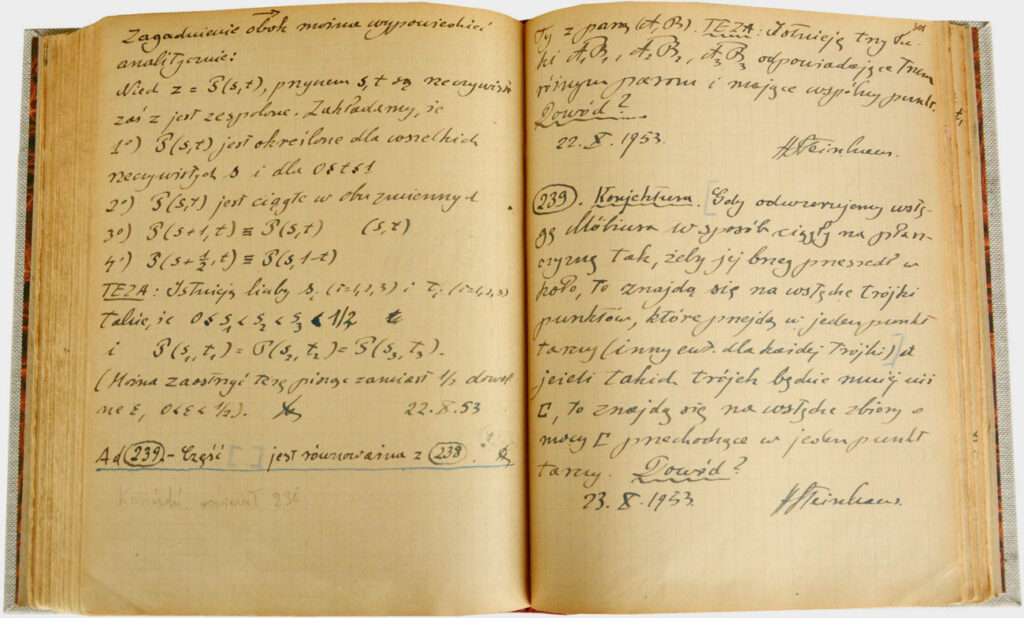
A New Start
The Old Scottish Book, Wroclaw and the New Scottish Book
The Germans stayed until the Soviets ousted them again on 27 July 1944 and the Ukrainian SSR was constituted. A Ukrainization process was applied throughout the SSR. Lucy Banach was compulsorily repatriated to Wroclaw in 1946, after the death of her husband. She travelled with her son, and with the Scottish Book in her luggage. Lucy died in 1957. The Book is now in the possession of her son Dr Stefan Banach Jr. Bogdan Mis reports [31] a sighting:
After a while, Dr. Banach brought out a large reel-to-reel tape box and from it extracted a neat, old-fashioned notebook, with a “marbled” effect cover. Even before it opened, I was already speechless with shock, guessing what it was. Yes! It was the famous Scottish Book, perhaps the greatest relic of Polish mathematicians, known throughout the world, which many thought was lost! The Scottish Book – a collection of problems and solutions to these problems, the results of a circle of brilliant Lwów mathematicians, with Stefan Banach, the father of my interlocutor, at the helm. The Scottish Book, surrounded by a legend today, mentioned in a thousand anecdotes, priceless!
With due respect, we turned the slightly yellowed pages of the book, noting the handwriting of the most famous mathematicians today: Alexandrov, Sobolev, Schauder, Mazur, Kuratowski, von Neumann and many others. And among them – the sprawling handwriting of Stefan Banach, one of the greatest mathematical phenomena of our time, and yet one of the most interesting people of our country, the holder of a resume so rich and complex, which few scholars can boast.
After World War II, many of the surviving mathematicians from Lwów continued their work at the University of Wroclaw, including Prof Hugo Steinhaus. It was E. Marczewski’s decision to revive the tradition of the Scottish book by initiating The New Scottish Book. The first problems in the new Scottish Book were entered by Prof Steinhaus at the beginning of July 1946, a symbolic act, as he also added the last problem in
the old Book.
The new Book is in the Library of Mathematics Faculty of Wrocław University. Problems can be tackled on MathOverFlow (https://mathoverflow.net/users/105651/lviv-scottish-book). A working version of the original Book is here: http://www.math.lviv.ua/szkocka/view.php.
A copy of the original book stayed with Stanisław Ulam who had it translated into English and began circulating photocopies to key readers. This sparked interest and gave rise to what has been called “The Scottish School of Mathematics” (to the bemusement of the citizens of Glasgow and Inverness). An international conference was held in Denton Texas in 1979.
Conclusions
This paper is a contribution to the History of Computing in Eastern Europe, and yet it focuses on a group of mathematicians and their conversations in a Café in the years up to 1942. How does this relate to a history of computing? There are two main devices for tying the narrative together.
The first relates to the practical applications of mathematics in subsequent years. Now, most (but not all – Ulam was a notable exception) mathematicians are notoriously irritable when faced with the question, “what practical use does this have?” They see it as a question coming from another frame of reference. For them, the objective of great pure mathematics is to find perfect solutions to mathematical problems. Most of the mathematicians sitting at that table were simply not interested in how one might apply one of their insights to building a better bridge or improving the taste of coffee. The key thing was to make beautiful and unassailable mathematics.
The fact is, of course, that much of their beautiful mathematics has embedded itself inextricably in the computer age. To quote Ulam again (cf. [13], p. 32):
In a conversation in the coffee house, Mazur proposed the first examples of infinite mathematical games. I remember also (it must have been sometime in 1929 or 1930), that he raised the question of the existence of automata which would be able to replicate themselves, given a supply of some inert material. We discussed this very abstractly, and some of the thoughts which we never recorded were actually precursors of theories like that of von Neumann’s on abstract automata. We speculated frequently about the possibility of building computers which could perform exploratory numerical operations and even formal algebraical work.
But conversation is speech and ideas are ideas. More practically, Ulam and von Neumann were part of the team that developed the first general-purpose electronic computer, the ENIAC, and participated in a review of results from these calculations. Ulam later worked on further prototype models. That’s as direct a link as you can have.
Here are some examples of other practical applications of Lwów mathematics, in no particular order:
- Banach spaces are used in spacecraft and missile trajectory planning
- Vector spaces enable 4G-smartphones to quickly carry out certain transformations (DFT/IDFT) in certain (for example) 1024-dimensional subspaces of the space of (periodic) functions
- The Hahn-Banach theorem applied to the Black-Scholes equation, an important computer algorithm in calculating arbitrage values
- Banach was the founder of modern functional analysis – the entire realm of quantum field theory (analytic regularizations in quantum theories), with the calculations of Feynman propagators, gauge theories, scattering amplitudes and all the rest is entirely based on functional analysis
- Much of the theory of probability can be considered as a branch of functional analysis and almost all current work descends from the Lwów School
- Auerbach’s lemma and his work on convex bodies are applied in materials science and in packaging
- Game theory and the Monte Carlo method (Ulam’s contributions) appear in a wide range of computer and business applications
- Number theory devised in Lwów is being used in cryptography and cryptanalysis, and in data compression algorithms
- The Kaczmarz method provides the basis for many modern imaging technologies, including the CAT scan….
I am sure there are many other examples to be found of practical applications.
It is also worth mentioning that the study of mathematics is riddled with the names of these Polish mathematicians – there are over 20 mathematical ideas with Banach’s name attached, such as the Banach space, Banach bundle, Banach algebra, and so on. Auerbach, Kuratowski, Mazur, Orlicz and Schauder are not far behind in numbers of mathematical terms and concepts attached to their names. Sierpiński names three fractals for us – a triangle, carpet and curve. The Lwów School will endure for quite a while yet. All of their names are part of the continuing discourse. Papers citing their works keep being published by the thousands.
Finally, in this attempt to conclude, it may be worth reflecting how this happened. What were the factors that led to the sudden outburst of mathematics, logic and philosophy, law and literature, in Lwów during the interwar years? Was it something in the water?
As my paper indicates, the long stifling of Polish intellectual contribution to the rapid scientific and technological development between 1795 and 1918, the prohibition on using the Polish language seemed to have a pressure-cooker effect. The minute the repression was lifted, the ideas began to flow.
This urge to let ideas flow was strongly abetted by the spirit of post-War iconoclasm, which operated on a number of levels. Youth, tired of the constrictions and dangers of war, brought in the Jazz Age, and with it a more democratic and egalitarian air, and with adventures in all the arts. From Europe, there were the more radical first cultural explosions of Dadaism and Surrealism, Kafka’s works were trickling in from Prague, while there had been a complete bloody revolution in Russia. This was certainly the time when people felt the ability and the need to think radically, and it gave rise to such extraordinary bursts of creativity as the Lwów School of Mathematics.
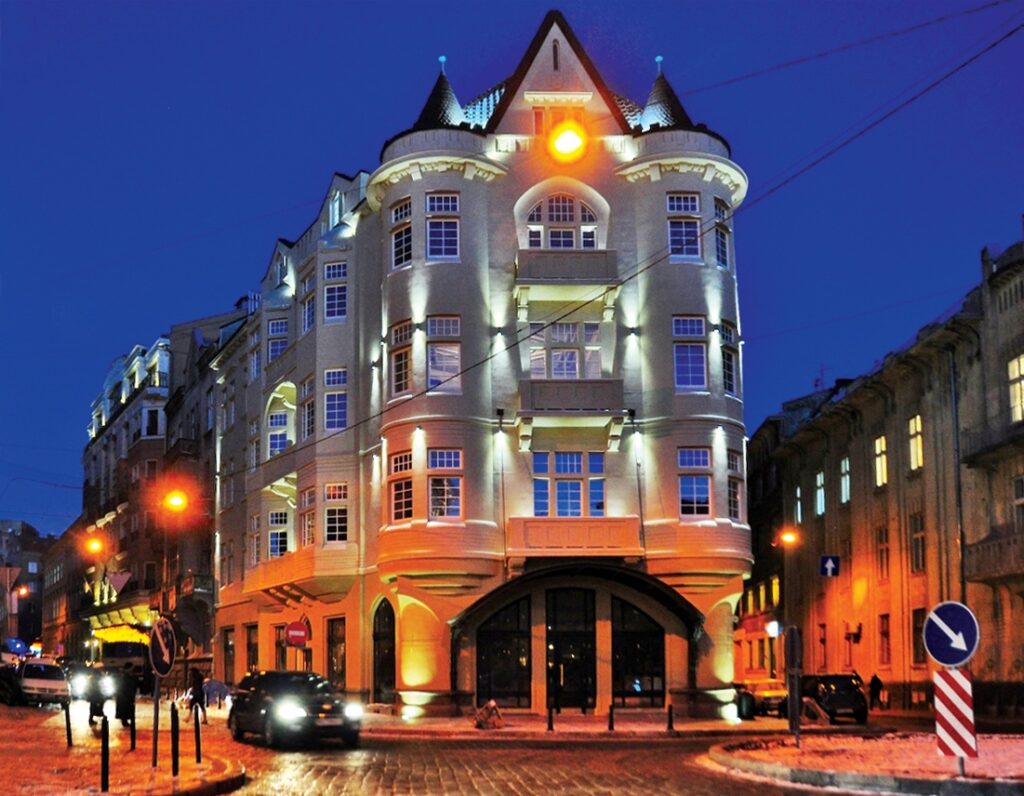
Epilogue: The Scottish Café Today
In a sense, the Scottish Café itself also presents a spectacular story of escape, and has its own colourful career. Somehow, like the rest of Lwów/Lviv, Brochwicz-Lewinski’s building looks untouched by bombs or bullets. Without seemingly turning a hair, it has weathered hot and cold wars and national and supra-national revolutions.
Since World War II, the Café has suffered the indignity of becoming a bank, and subsequently it went completely under cover for a few years as the Desertniy (Desert) Bar. However, in 2014 it reopened as the Scottish Café again, now part of the ground floor of the Atlas Hotel, an elegant boutique establishment, which occupies the rest of the building.
Visitors to the Café who express an interest are shown a facsimile copy of the Scottish Book, brought out of some hiding place by a manager or waiter, just as it would have been proffered during the 1930s. The tables are small and square, as they used to be, but they no longer have marble tops: you have to scribble your mathematics on a napkin or tap your tablet.
Given the present-day hotel’s need for a reception area, the Café no longer occupies the whole ground level. It is small, cosy and new. However the floors – which are laid in white marble veined with black, and set in a herringbone pattern with a dotted line of marble rectangles along the edges – is the original floor. You can admire it while imagining the footsteps of your favourite illustrious mathematician walking across it in his – and its – heyday.
So I will leave you with thoughts of Banach standing there tall and blond, greeting the swarthy von Neumann, with Mazur and Ulam spinning mathematical spells or telling jokes beside him, Steinhaus eloquent and dapper in a frock coat, Auerbach rising from a game of chess in someone’s dirty hat, Chwistek tapping across the floor in mismatched shoes. …
… while I observe my grandfather, decorative cane in hand, in a light suit and with a somewhat severe expression, strolling across to my table to say hello. \blacksquare
References
- [12] Urbanek M.: Genialni: Lwówska szkoła matematyczna. Iskry, Warsaw. ISBN: 9788324403813 EAN: 9788324403813. (2014), p. 27.
- [13] Ulam, S.M. Adventures of a Mathematician. University of California Press, Oakland. ISBN 0-520-07154-9 (1991), p. 33.
- [14] Okulicz-Kozaryn, R: Gest pięknoducha : Roman Jaworski i jego estetyka brzydoty. Instytut Badań Literackich PAN. Wydaw., Warsaw. ISBN 83-89348-09-8 (2003), p. 158.
- [15] Ficowski, J.: Regions of the Great Heresy: Bruno Schulz – A Biographical Portrait. Norton & Co., New York. ISBN 978-0-393-32547-8 (2003).
- [16] Sands, P: East West Street. Weidenfeld and Nicolson (2016), p. 464.
- [17] Zelazko, W.: A short history of Polish mathematics, Mathematical Institute, Polish Academy of Sciences, Warsaw (2017) https://www.researchgate.net/publication 228701193\_A\_short\_history\_of\_Polish\_mathematics last accessed 2018/11/20, p. 1.
- [18] Steinhaus, H: Stefan Banach.Studia Mathematica, Seria Specjalna, Z.I. (1963), pp. 7-15.
- [19] Ulam, S: Annals of the Polish Mathematical Society Series II: Wiadomosci matematyczne /Messiah Announcements XII (1969), pp. 49-58.
- [20] Jakimowicz E., Miranowicz A.: A w Szkockiej: Burze w Muzgu (Brainstorm in the Scottish Café) (2017).
- [21] Urbanek, M: Genialni: Lwówska szkola matematyczna./Wydawnictwo Iskru, Warsaw (2014), p. 111.
- [22] Ulam, S.M. Adventures of a Mathematician. op cit, p. 32.
- [23] Bakula, B.: Comparison as evidence. Polish-Ukrainian cultural, literary and historical relations 1890-1999. Wyd. Naukowe UAM, Poznań, (2001), pp. 207-219.
- [24] Duda, R.: Lwówska szkoła matematyczna, 2nd Ed Uniwersytet Wrocławski, Wrocaw. ISBN: 978-83-229-3211-7 (2014) (Also available in English as Duda, R. Pearls from a Lost City: The Lvov School of Mathematics. (translated from Polish by Daniel Davies). American Mathematical Society, Providence, USA. ISBN 978-1470410766) (2014).
- [25] Rakhiel, Y.: Scottish Book: Lviv’s mathematical relic – About the role of Ukrainian scientists in the formation of new mathematics. op cit.
- [26] Steinhaus, H: Stefan Banach op cit.
- [27] Miś, B.: Opowieści Księgi Szkockiej (Tales of the Scottish Book). Perspectives No. 12, 1719 (1969).
- [28] Rakhiel, Y.: Scottish Book: Lviv’s mathematical relic – About the role of Ukrainian scientists in the formation of new mathematics. op cit.
- [29] Zelazko, W.: A short history of Polish mathematics, Mathematical Institute, Polish Academy of Sciences, Warsaw (2017).
- [30] Section adapted from Rakhiel, Y.: Scottish Book: Lviv’s mathematical relic – About the role of Ukrainian scientists in the formation of new mathematics. op cit.
- [31] Miś, B.: Opowieści Księgi Szkockiej (Tales of the Scottish Book) op cit.
Background literature
- Bylczynska, M.: Pamietnik Galicjanki (1914-17) Mnemosyne No 1 Ed. Maciej DęborógBylczyński. Oficyna Wydawnicza Zakładu Aktywności Zawodowej im. Jana Pawła II, Branice, Warsaw. ISBN 978-83-62319-04-6. (2012)
- Kaluza, R.: Through a Reporter’s Eyes: The life of Stefan Banach Boston, Springer (1995)
- Kuratowski, K.: Pól wieku matematyki polskiej, 1920-1970. Biblioteka wiedzy współczesnej, Omega, Warsaw (1973) (Also available in English as Kuratowski, K. A Half Century of Polish Mathematics – Remembrances and Reflections. Pergamon Press, Oxford. ISBN-10: 0080230466 ISBN-13: 978-0080230467 (1980))
- Mekarski, S. : Lwów: Karta z Dziejów Polski. Naklada Kola Lwówian, London. (1962)
- Okulicz-Kozaryn, R.: The gesture of the great-hearted man: Roman Jaworski and his aesthetics of ugliness. Institute of Literary Research of the Polish Academy of Sciences, Warsaw. ISBN 83-89348-09-8. (2003)
- Schleyen, K.: Lwówskie Gawedy. Gryf, London (1967)
- Stefan Banach: Remarkable Life, Brilliant Mathematics, Ed by Jakimowicz E., Miranowicz, A. American Mathematical Society; 3 edition. ISBN-10: 8373264515 (2011) 185 pages
- Szałajko, K.: Research Notebooks AGH IM. S. Staszica. Opuscula Mathematica 1522 (13) 45-54. Krakow (1993)
- Szolginia,.W.: Zycie miasta Vol 5, Wysoki Zamek, Wrocław (1994)
- Wasylewski, S.: Lwów. R. Wegner Publishers, Poznan. 173 p. (1935)
- Sometimes incorrectly attributed to Paul Erdös (see [9]). ↩
- Possibly meant to be a distortion [incorporating Banach’s name] of the word Bacchanalia, alluding to the ‘drunken celebrations’ during the Roman festivals of Bacchus, the Greco-Roman god of wine, freedom, intoxication and ecstasy. ↩
- A group of early twentieth-century philosophers who sought to reconceptualize empiricism by means of their interpretation of then recent advances in the physical and formal sciences. ↩
- First appearing in the epigraph of Ernest Hemingway’s book Fiesta: The Sun Also Rises in 1926, this term was brought to light by Gertrude Stein, an American modernist author who moved to Paris in 1903 and worked as a mentor for a group of young American writers living abroad after World War I. ↩
- There is already an attempt to do so in Wroclaw [6]. ↩
- In this paper, I am using the names Lemberg, Lwów and Lviv, according to whether at the time the city was a part of Austria-Hungary, Poland or either the Soviet Union or Ukraine. Some essential history: 1) When Hitler invaded Poland in September 1939, the Germans crossed the whole of the country and reached as far as Lwów in the East; 2) Then they stopped and handed over the eastern section, including Lwów, to their Soviet allies (a result of the Molotov-Ribbentrop Pact), and retreated to the present-day Polish border; 3) Between October 1939 and May 1941, Lwów was under Soviet control. 4) In June 1941, with Germany and the Soviet Union allies no longer, the Germans ousted the Soviets from Lwów and stayed until the end of the War. 5) Lwów then became a city in the Ukrainian SSR; and 6) it is now a part of independent Ukraine. ↩
- Except as otherwise indicated this section is based on https://pl.wikipedia.org/wiki/Zbigniew_Brochwicz-Lewi\%C5\%84ski, last accessed 2018/11/18. ↩
- http://www.lvivtoday.com.ua/lviv-personality/4169, last accessed 2018/11/18. ↩
- The historical description of the building and plot section is derived from the Lviv Interactive entry ID: 2210 http://www.lvivcenter.org/en/lia/objects/pr-shevchenka-27/, last accessed on 2018/11/18. ↩
- Bakula B: Świat naukowo-artystyczny lwowskiej “knajpy” lat 30. (17 August 2004) eurozine.com http://www.eurozine.com/swiat-naukowo-artystyczny-lwowskiej-knajpy-lat30/ last accessed 2018/11/18. ↩
- Section derived from https://pl.wikipedia.org/wiki/Klub\_Konstrukcjonalist\%C3\%B3w last accessed on 2018/11/20. ↩
- https://philosophynow.org/issues/111/Alfred\_Tarski\_1901-1983, last accessed 2018/11/21. ↩
- “It is worth noting that at the time when Mazur was playing the futurologist [at the Café], Staszek Lem, one of the greatest authors of Science Fiction of our century, was about ten years old and running along Brajerowska Street in shorts” – From Brainstorm in the Scottish Café. ↩
- https://en.wikipedia.org/wiki/University\_of\_Lviv last accessed 2018/11/21. ↩
- Rakhiel, Y.: Scottish Book: Lviv’s mathematical relic – About the role of Ukrainian scientists in the formation of new mathematics, 1 April 2010, http://day.kyiv.ua/en/article/society/scottish-book-lvivs-mathematical-relic, last accessed 2018/08/17. ↩
- Thanks to Stan Ulam, the entire book was translated and published in English as The Scottish Book: Mathematics from the Scottish Café, Ed by Mauldin, R.D., Birkhäuser, Boston. ISBN 3-7643-3045-7 (1981). ↩
- Lice feeding: https://en.wikipedia.org/wiki/Feeder\_of\_lice, last accessed 2018/22/11. last accessed 2018/22/11 ↩
Appendix
Members of the Lwów School of Mathematics, what they did, and how their lives proceeded
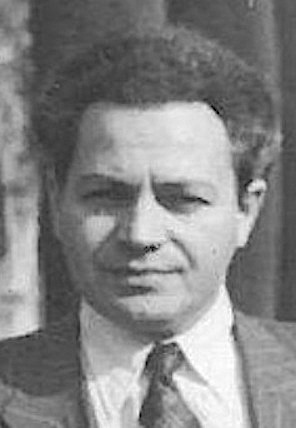
Mieczysław Altman : Functional analysis, numerical analysis, mathematical programming, general optimization theory, nonlinear differential and integral equations, and Banach algebras. A number of Altman’s results, such as the Generalized Newton’s method and the Newton-Altman method, are still in use today.
Banach’s last student, starting 1939 when he escaped from Warsaw. Escaped from Lwów in 1941, studied in the Soviet Union, left for the USA in 1970.
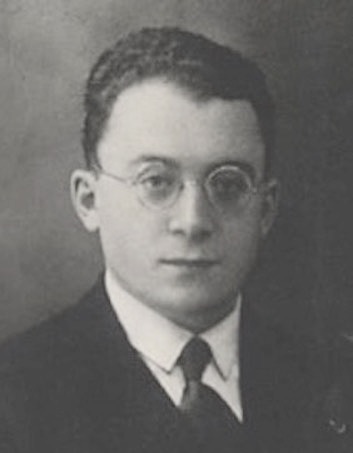
Herman Auerbach*: (In this section * denotes “leading member of the school”, according to Polish Wikipedia)
Theory of convex bodies, Auerbach’s lemma is still in constant use in areas such as C^{*}-algebras. “Contact graphs have emerged as an important tool in the study of translative packings of convex bodies and have found numerous applications in materials science.
He was either murdered at Bełżec extermination camp or committed suicide to avoid going there.

Stefan Banach* : Banach was the founder of modern functional analysis. the entire realm of quantum field theory, with the calculations of Feynman propagators, gauge theories, scattering amplitudes and all the rest is entirely based on functional analysis. Much of the theory of probability can be considered as a branch of functional analysis. The functioning of the 4G-smartphones depends on the phones ability to quickly carry out certain transformations (DFT/IDFT) in certain (for example) 1024-dimensional subspaces of the space of (periodic) functions. The concept of Banach spaces is used in spacecraft and missile trajectory planning. Quantum mechanics, optimization, Sobolev Spaces and partial differential equations. The list of things named after Banach is long, and includes: Banach algebra, Banach algebra cohomology, Banach bundle (non-commutative geometry), Banach–Mazur compactum, Banach fixed-point theorem, Banach function algebra, Banach game, Banach limit, Banach manifold, Banach measure, Banach norm, Banach space, Banach–Alaoglu theorem, Banach–Mazur game, Banach–Ruziewicz problem, Banach–Steinhaus theorem, Banach–Stone theorem, Banach–Tarski paradox, Banach’s matchbox problem, Hahn–Banach theorem,….
Was a lice-feeder at the Weigl Institute during the War years. Died of lung cancer in 1945, just as he was preparing to move to Krakow to teach. Buried in Lwów.
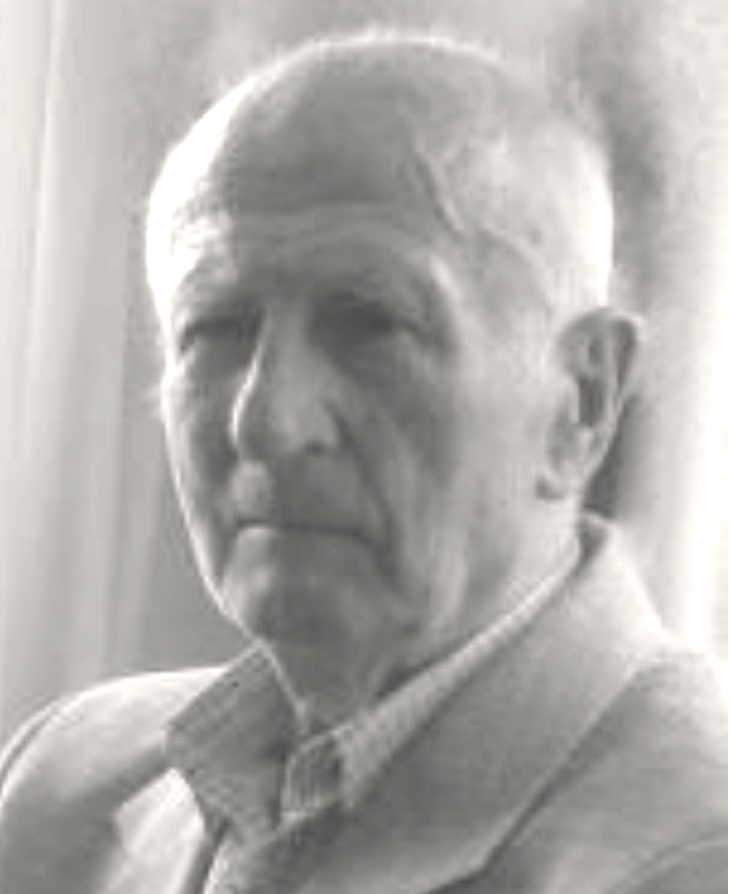
Feliks Baranski : Differential equations
Assistant to Banach and a lice-feeder, like Banach. Worked in Krakow University of Technology.
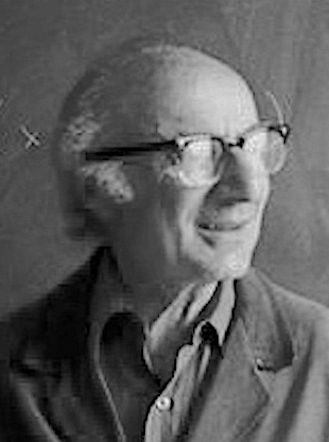
Zygmunt Wilhelm Birnbaum* : Functional analysis, nonparametric testing and estimation, probability inequalities, survival distributions, competing risks, and reliability theory.
Studied under Steinhaus. Worked as an actuary, before moving to the US in 1937. Professor of Mathematics at University of Washington.

Leon Chwistek* : Philosophy of mathematics. He applied his “doctrine of the plurality of realities” to mathematics and art. He was also a renowned avant-garde artist.
Died near Moscow of natural causes.

Max (Meier) Eidelheit* : Functional analysis, isomorphisms of rings of linear operators, automatic continuity – contributed problems to the Scottish Book. Eidelheit’s theorem on separation (on separation of convex sets in normed spaces).
Murdered by Nazis. Student of Banach.
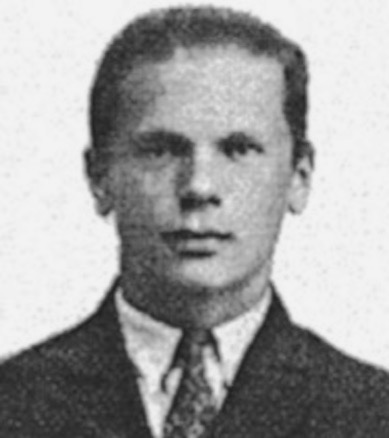
Władysław Hetper* : Problem of completeness of the system of elementary semantics, a system without axioms for sentential calculus – issues in mathematical logic and philosophy.
Probably died in a Soviet camp. His last letter to his family, from Starobielsk camp, was dated 1941.

Mark Kac* : Probability theory, spectral theory, theory of Fourier series, Feynman–Kac formula, statistical mechanics, number theory.
A student of Steinhaus, he moved to the US just before the War. Became a professor at Cornell, Rockefeller and USC.

Stefan Kaczmarz*: Kaczmarz method which provides the basis for many modern imaging technologies, including the CAT scan; theory of orthogonal series.
Circumstances of death not known – suspected murdered with Army officers in Katyn.
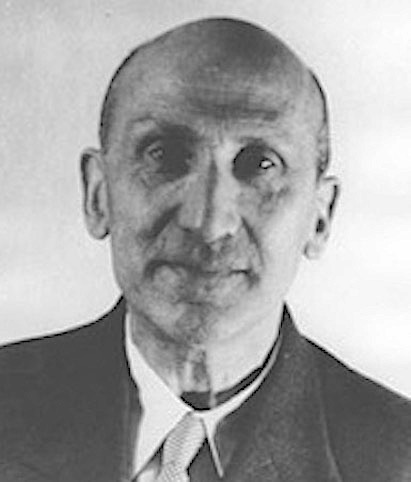
Bronisław Knaster: Point-set topology. in 1922 discovered the hereditarily indecomposable continuum or pseudo-arc and of the Knaster continuum, or bucket handle continuum. He also developed the “last diminisher” procedure for fair cake cutting. Knaster–Tarski theorem, Knaster–Kuratowski fan, Knaster’s condition.
Student of Steinhaus. Like Banach, he was a lice-feeder at the Weigl Institute. Became professor in Wroclaw.

Edward Kofler : Game theory, fuzzy sets, incompleteness (of information) theory, “partial information theory”. His work was further developed by John von Neumann.
During the war, escaped to Kazakhstan and ran a children’s home in Alma-Ata. Emigrated to Switzerland in 1969.
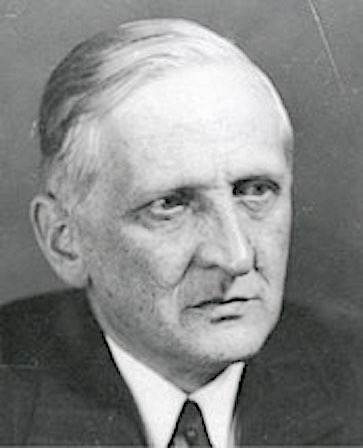
Antoni Marian Łomnicki*: His work was in training engineers, writing popular school books and textbooks about mathematics.
Murdered by Nazis in Murder of Professors.

Stanisław Mazur*: Geometrical methods in linear and nonlinear functional analysis, Banach algebra, summability theory, infinite games and computable functions. Known for numerous results in functional analysis. (one of his classical results says that the convex envelope of a compact subset of a Banach space is again compact). The Mazur–Gelfand theorem is widely known. Mazur also collaborated closely with Orlicz obtaining results in non-linear functional analysis (polynomial operators) and in locally convex spaces.
Taught at University of Warsaw. Long-time member of the communist party.

Władysław Nikliborc*: An academic administrator and teacher, rather than an applied mathematician. Played chess with Auerbach and others at the Scottish Café.
Faculty Dean. Moved to the Warsaw Polytechnic. Died under interrogation by Polish Public Defence authorities.

Kazimierz Kuratowski*: Set theory and topology. His characterization of topological spaces now called Kuratowski closure axioms; he proved the Kuratowski–Zorn lemma; in graph theory, the characterization of planar graphs is now known as Kuratowski’s theorem; identification of the ordered pair (x,y) with the set \{{ x }, {x,y}\}; the Kuratowski finite set definition, see Kuratowski-finite; introduction of the Tarski–Kuratowski algorithm; Kuratowski’s closure-complement problem; Kuratowski’s free set theorem; Kuratowski convergence of subsets of metric spaces; the Kuratowski and Ryll–Nardzewski measurable selection theorem; topology: robots, finding patterns in big data sets.
He left for Warsaw before the Scottish Book, but is nevertheless counted a member of the Lwów School.

Stanisław Ulam*: Many results with Banach, Mazur and others in the Lwów School. In the US, participated in the Manhattan Project to develop the A-bomb, originated the Teller–Ulam design of thermonuclear weapons, discovered the concept of cellular automaton, invented the Monte Carlo method of computation, and suggested nuclear pulse propulsion. Also worked on ENIAC, “the first general purpose computer”.
Left Lwów just before WWII broke out, and spent the rest of his life in the USA. In the US, worked at Harvard University, the Institute for Advanced Studies in Princeton and Los Alamos.

Władysław Orlicz*: Orlicz spaces, non-linear functional analysis (polynomial operators) and locally convex spaces. Known for his results on orthogonal series, real functions, summability theory and functional analysis (polynomial operators, interpolation of operators and theory of modular spaces). Applications in statistics and probability.
A lice-feeder, like Banach.
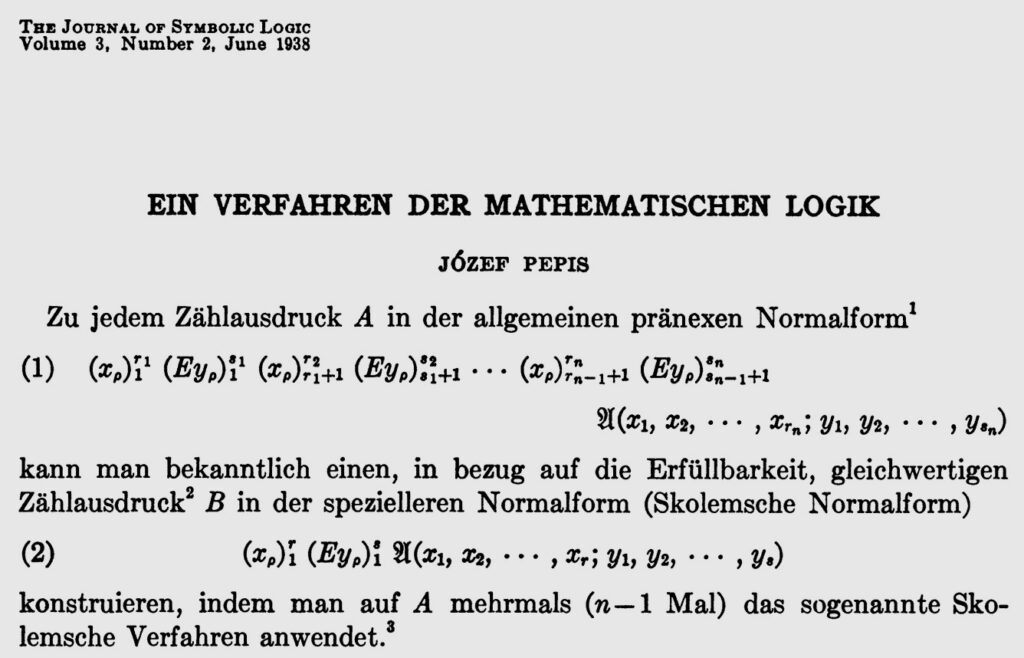
Jözef Pepis* (1910–1941)
Mathematical logic.
Murdered by Nazis. He, however, survives in his work.
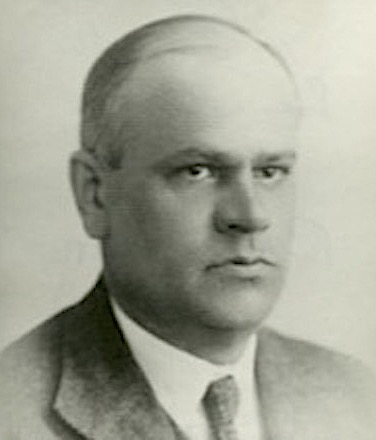
Stanisław Ruziewicz*: Set theory and real functions.
Murdered by Nazis in Murder of Professors.

Stanisław Saks* : Theory of integrals.
Murdered by Nazis in Warsaw.
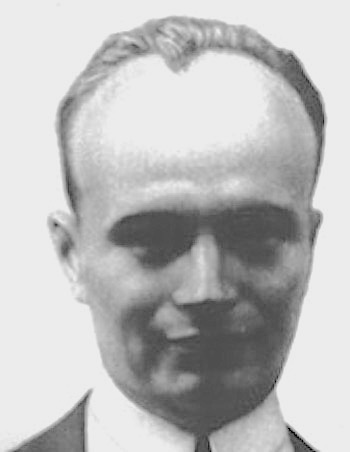
Juliusz Paweł Schauder*: Schauder bases, functional analysis, partial differential equations and mathematical physics. Associated with his name are the Schauder basis, Schauder fixed-point theorem and the Lerey–Schauder theory of non-linear completely continuous operators (with topological methods based upon the concept of an index and with applications to partial differential equations).
Shot by Nazis in Lwów ghetto.

Józef Schreier: Functional analysis, Group theory, combinatorics, topology. Baire–Schreier–Ulam theorem, Schreier–Ulam theorem.
Contributed to the Scottish Book. Died in an underground bunker when the Germans came – committed suicide by cyanide rather than be captured.
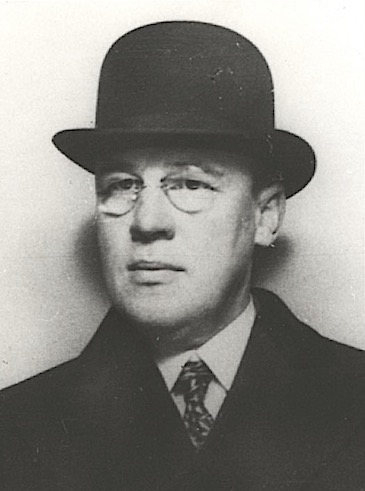
Wacław Sierpiński: Set theory, number theory, theory of irrational numbers, theory of functions and topology – three well-known fractals named after him: the Sierpiński triangle, carpet and curve \& Sierpiński numbers, “In 1916, Sierpiński gave the first example of an absolutely normal number.”
Apart from teaching in Lwów 1908-1914, he wasn’t really Lwów School – he studied and taught in Warsaw.
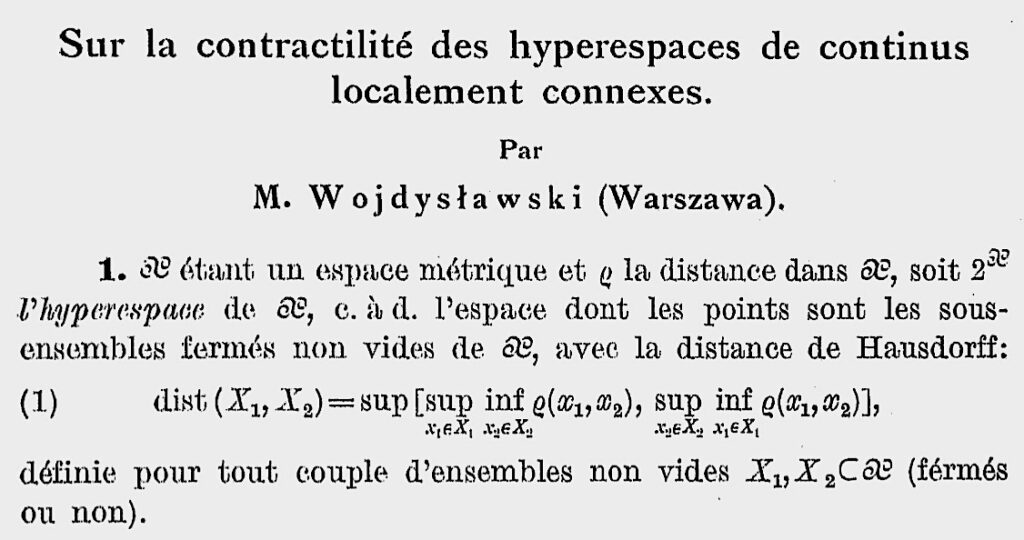
Menachem (Maniek) Wojdysławski (1919–1942)
Important work in topology, which is still being cited and developed.
Died at an unknown time, under unknown circumstances. According to one version, he died in 1942 in Lwów and, according to another, he was probably murdered during the liquidation, in 1943, of the ghetto in Częstochowa, where he was last seen staying. He, however, survives in his work.
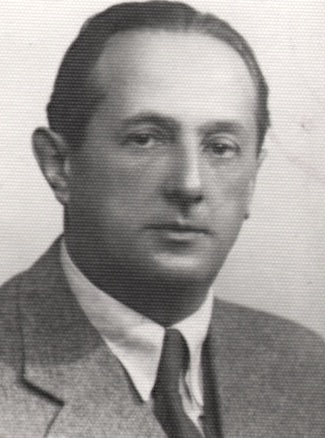
Hugo Steinhaus*: Banach–Steinhaus theorem, and many other results – although he claimed that his greatest discovery was not a mathematical formula, but Stefan Banach.
Became professor in Wroclaw.

Ludwik Sternbach: Borelian types of linear qualities, convergence sets of linear operations. From 1929, he worked part-time as an editor for the newly established Studia Mathematica.
Died in the Bełżec extermination camp.
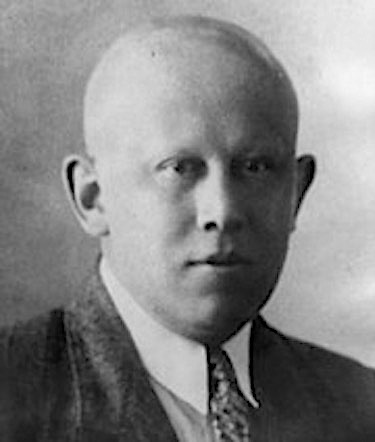
Włodzimierz Stożek* : Theory of integral equations, logarithmic and potential theory.
One of those murdered by Nazis in the Murder of Professors.
